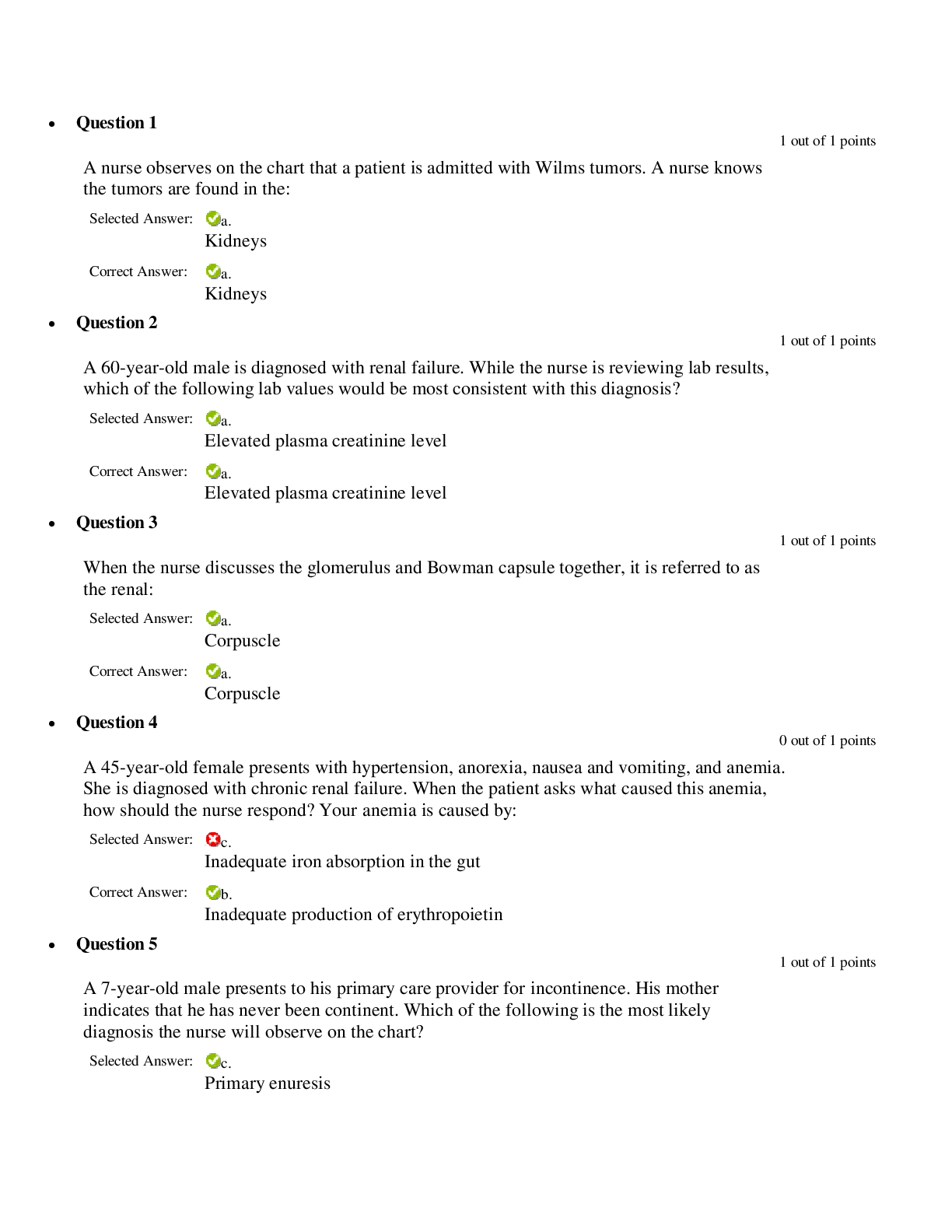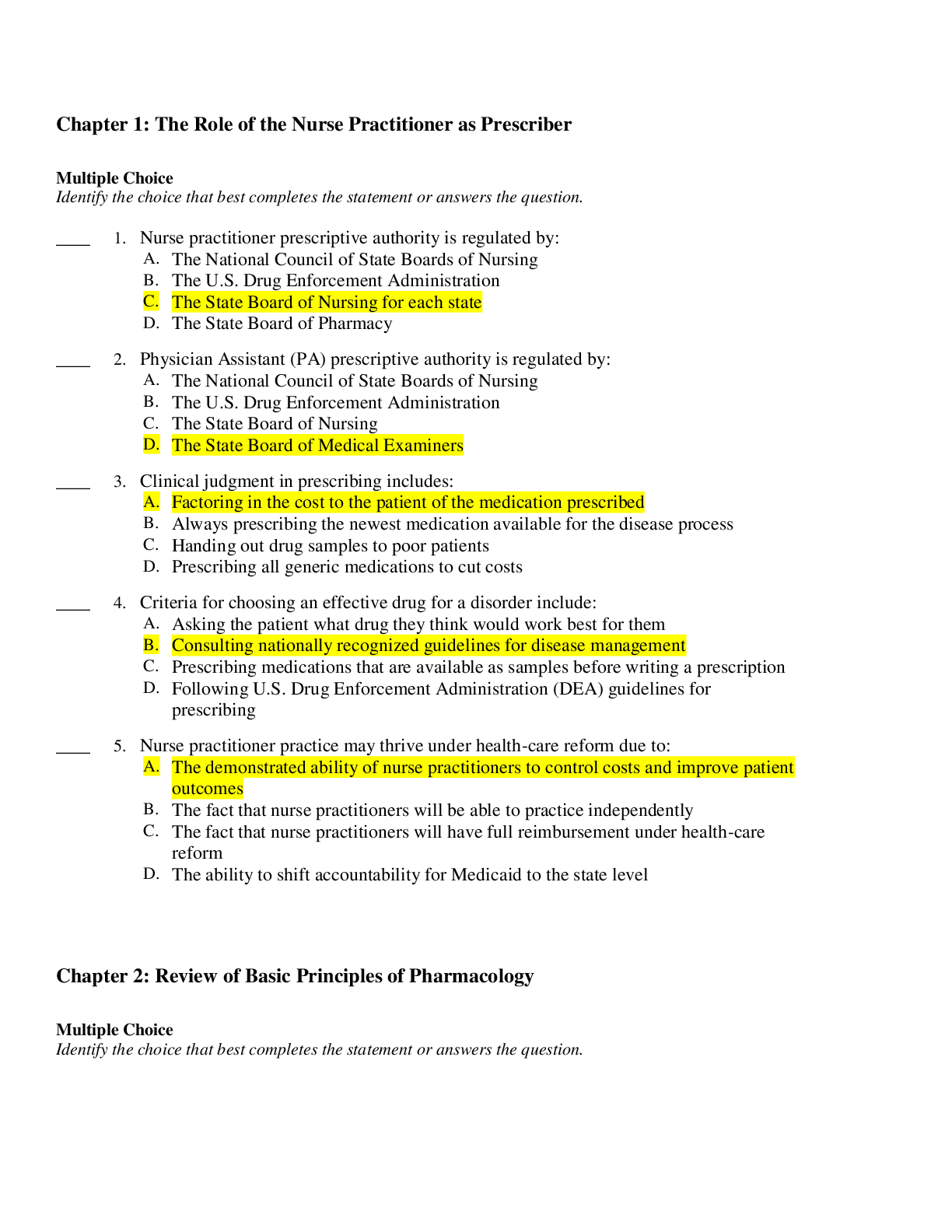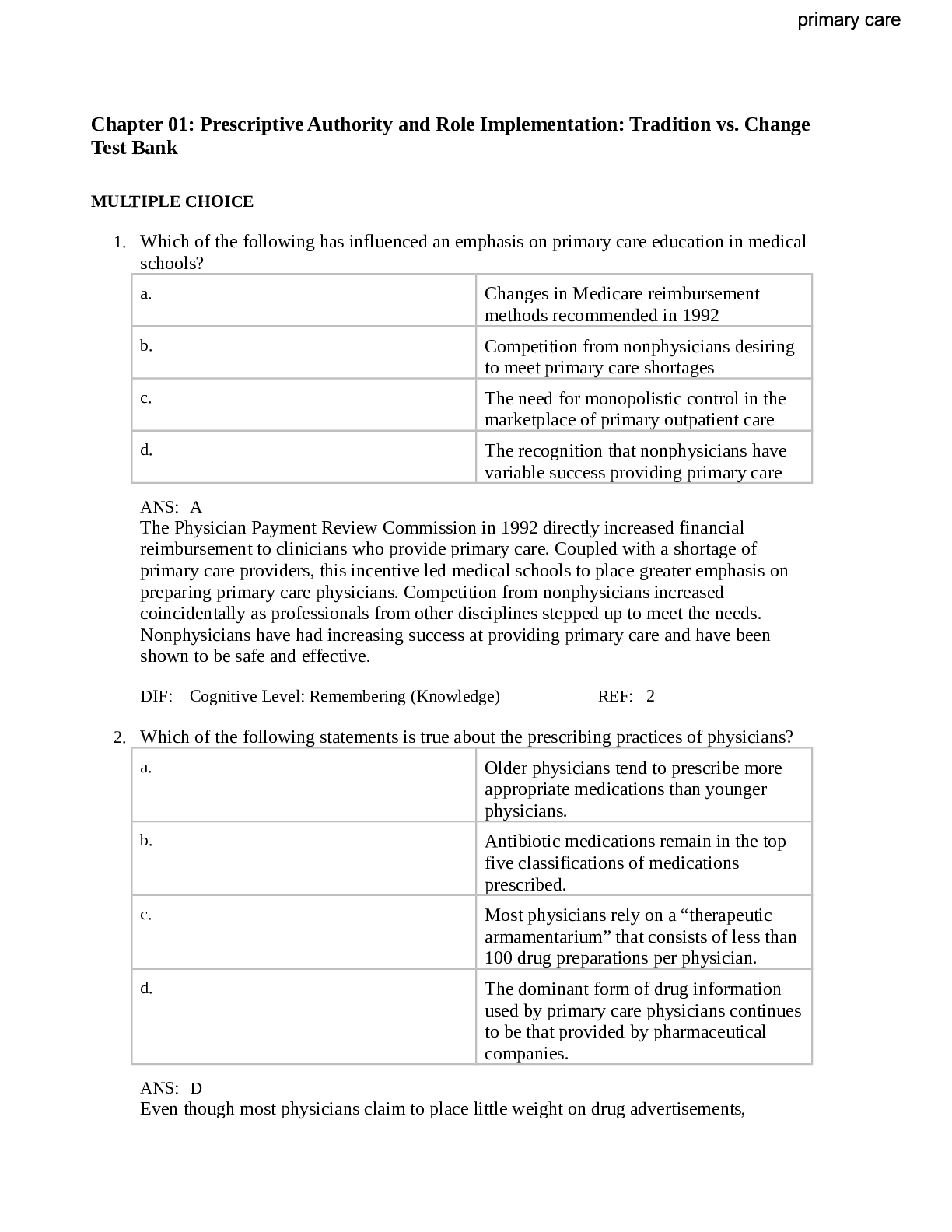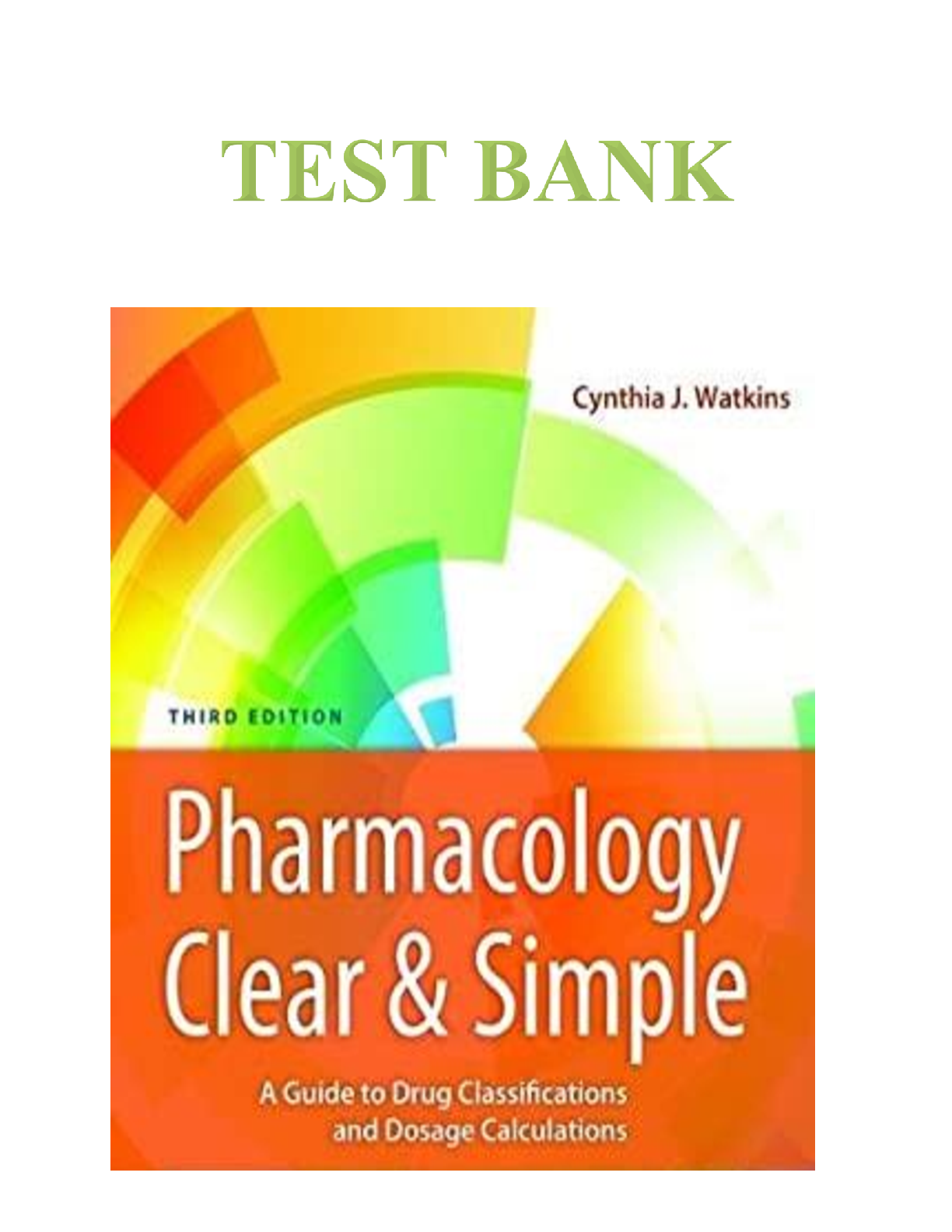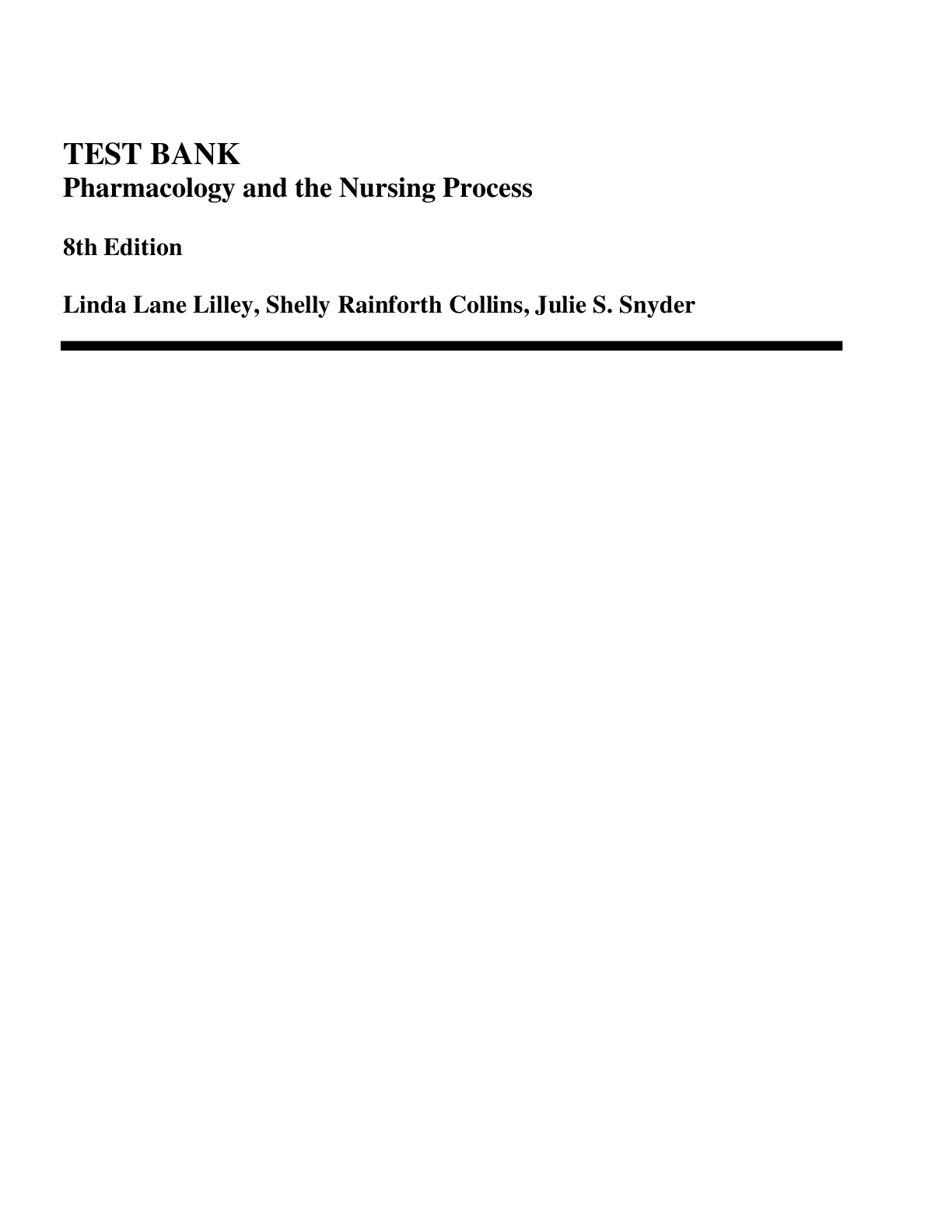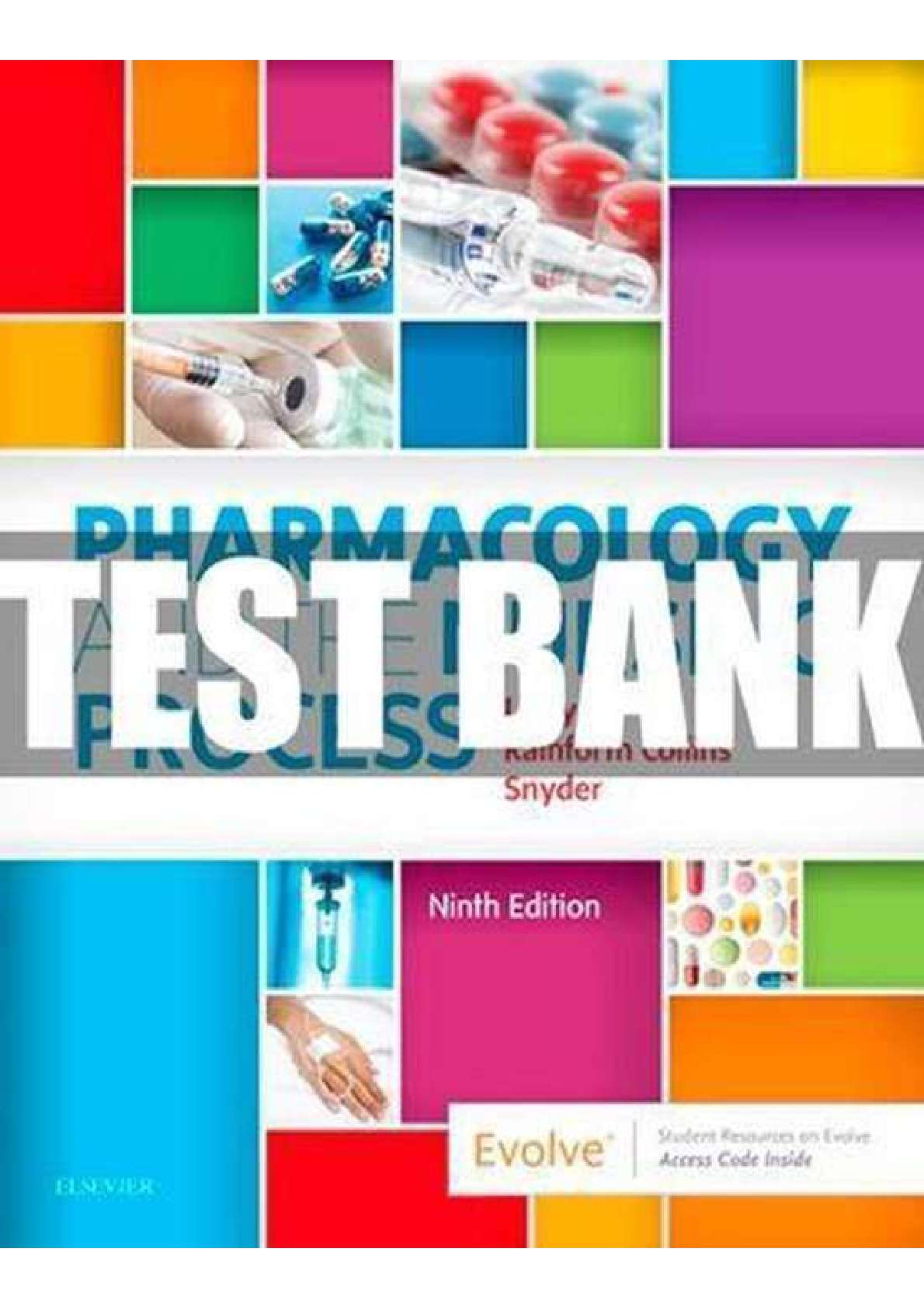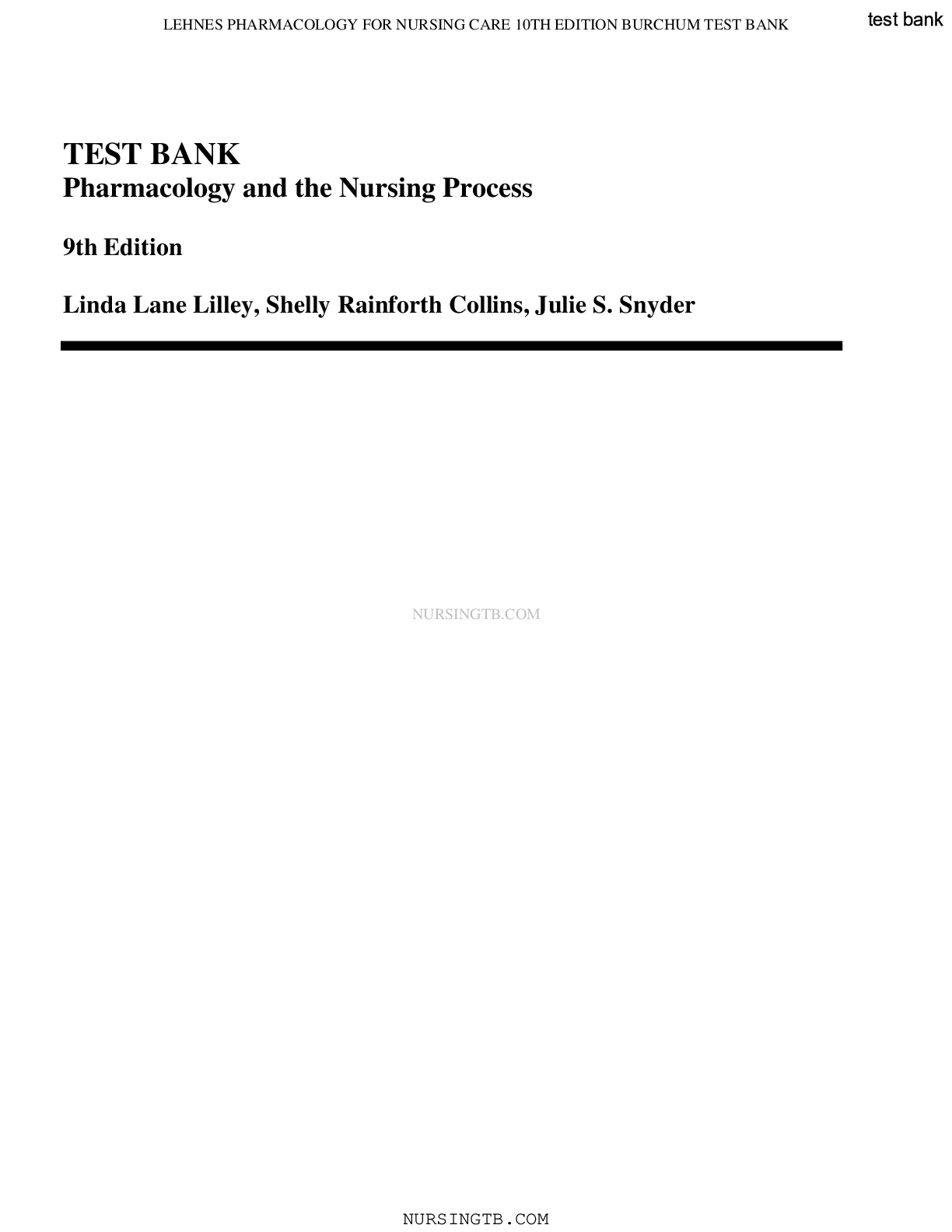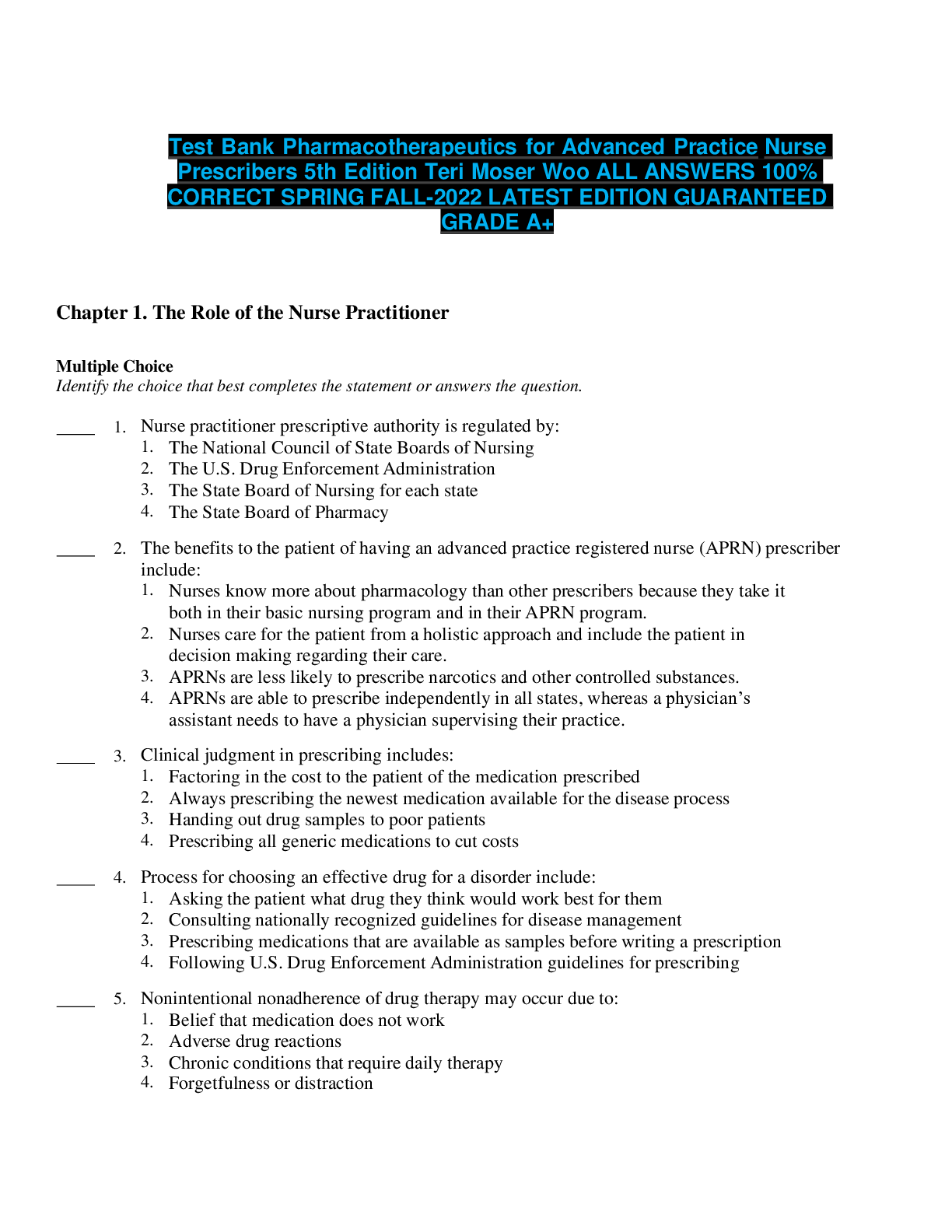*NURSING > EXAM > NURSING NGR 5035 > Florida National University - NURSING NGR 5035 Test bank pharmaco (Final Exam) (V (All)
NURSING NGR 5035 > Florida National University - NURSING NGR 5035 Test bank pharmaco (Final Exam) (Verified answers, Scored A)
Document Content and Description Below
Chapter 1: The Role of the Nurse Practitioner as Prescriber Multiple Choice Identify the choice that best completes the statement or answers the question. 1.Nurse practitioner prescriptive authority i... s regulated by: A. The National Council of State Boards of Nursing B. The U.S. Drug Enforcement Administration C. The State Board of Nursing for each state D. The State Board of Pharmacy 2.Physician Assistant (PA) prescriptive authority is regulated by: A. The National Council of State Boards of Nursing B. The U.S. Drug Enforcement Administration C. The State Board of Nursing D. The State Board of Medical Examiners _3.Clinical judgment in prescribing includes: A. Factoring in the cost to the patient of the medication prescribed B. Always prescribing the newest medication available for the disease process C. Handing out drug samples to poor patients D. Prescribing all generic medications to cut costs 4.Criteria for choosing an effective drug for a disorder include: A. Asking the patient what drug they think would work best for them B. Consulting nationally recognized guidelines for disease management C. Prescribing medications that are available as samples before writing a prescription D. Following U.S. Drug Enforcement Administration (DEA) guidelines for prescribing 5.Nurse practitioner practice may thrive under health-care reform due to: A. The demonstrated ability of nurse practitioners to control costs and improve patient outcomes B. The fact that nurse practitioners will be able to practice independently C. The fact that nurse practitioners will have full reimbursement under health-care reform D. The ability to shift accountability for Medicaid to the state level Chapter 2: Review of Basic Principles of Pharmacology Multiple Choice Identify the choice that best completes the statement or answers the question. ____ 1. A patient’s nutritional intake and lab work reflects hypoalbuminemia. This is critical to prescribing because: A. Distribution of drugs to target tissue may be affected B. The solubility of the drug will not match the site of absorption C. There will be less free drug available to generate an effect D. Drugs bound to albumin are readily excreted by the kidney ____ 2. Drugs that have a significant first-pass effect: A. Must be given by the enteral (oral) route only B. Bypass the hepatic circulation C. Are rapidly metabolized by the liver and may have little if any desired action D. Are converted by the liver to more active and fat-soluble forms ____ 3. The route of excretion of a volatile drug will likely be: A. The kidneys B. The lungs C. The bile and feces D. The skin ____ 4. Medroxyprogesterone (Depo Provera) is prescribed IM to create a storage reservoir of the drug. Storage reservoirs: A. Assure that the drug will reach its intended target tissue B. Are the reason for giving loading doses C. Increase the length of time a drug is available and active D. Are most common in collagen tissues ____ 5. The NP chooses to give cephalexin every 8 hours based on knowledge of the drug’s: A. Propensity to go to the target receptor B. Biological half-life C. Pharmacodynamics D. Safety and side effects ____ 6. Azithromycin dosing requires the first day’s dose be twice those of the other 4 days of the prescription. This is considered a loading dose. A loading dose: A. Rapidly achieves drug levels in the therapeutic range B. Requires four to five half-lives to attain C. Is influenced by renal function D. Is directly related to the drug circulating to the target tissues ____ 7. The point in time on the drug concentration curve that indicates the first sign of a therapeutic effect is the: A. Minimum adverse effect level B. Peak of action C. Onset of action D. Therapeutic range ____ 8. Phenytoin requires a trough level be drawn. Peak and trough levels are done: A. When the drug has a wide therapeutic range B. When the drug will be administered for a short time only C. When there is a high correlation between the dose and saturation of receptor sites D. To determine if a drug is in the therapeutic range ____ 9. A laboratory result indicates the peak level for a drug is above the minimum toxic concentration. This means that the: A. Concentration will produce therapeutic effects B. Concentration will produce an adverse response C. Time between doses must be shortened D. Duration of action of the drug is too long ____ 10. Drugs that are receptor agonists may demonstrate what property? A. Irreversible binding to the drug receptor site B. Up-regulation with chronic use C. Desensitization or down-regulation with continuous use D. Inverse relationship between drug concentration and drug action ____ 11. Drugs that are receptor antagonists, such as beta blockers, may cause: A. Down-regulation of the drug receptor B. An exaggerated response if abruptly discontinued C. Partial blockade of the effects of agonist drugs D. An exaggerated response to competitive drug agonists ____ 12. Factors that affect gastric drug absorption include: A. Liver enzyme activity B. Protein-binding properties of the drug molecule C. Lipid solubility of the drug D. Ability to chew and swallow ____ 13. Drugs administered via intravenous (IV) route: A. Need to be lipid soluble in order to be easily absorbed B. Begin distribution into the body immediately C. Are easily absorbed if they are nonionized D. May use pinocytosis to be absorbed ____ 14. When a medication is added to a regimen for a synergistic effect, the combined effect of the drugs is: A. The sum of the effects of each drug individually B. Greater than the sum of the effects of each drug individually C. Less than the effect of each drug individually D. Not predictable, as it varies with each individual ____ 15. Which of the following statements about bioavailability is true? A. Bioavailability issues are especially important for drugs with narrow therapeutic ranges or sustained release mechanisms. B. All brands of a drug have the same bioavailability. C. Drugs that are administered more than once a day have greater bioavailability than drugs given once daily. D. Combining an active drug with an inert substance does not affect bioavailability. ____ 16. Which of the following statements about the major distribution barriers (blood-brain or fetal-placental) is true? A. Water soluble and ionized drugs cross these barriers rapidly. B. The blood-brain barrier slows the entry of many drugs into and from brain cells. C. The fetal-placental barrier protects the fetus from drugs taken by the mother. D. Lipid soluble drugs do not pass these barriers and are safe for pregnant women. ____ 17. Drugs are metabolized mainly by the liver via Phase I or Phase II reactions. The purpose of both of these types of reactions is to: A. Inactivate prodrugs before they can be activated by target tissues B. Change the drugs so they can cross plasma membranes C. Change drug molecules to a form that an excretory organ can excrete D. Make these drugs more ionized and polar to facilitate excretion ____ 18. Once they have been metabolized by the liver, the metabolites may be: A. More active than the parent drug B. Less active than the parent drug C. Totally “deactivated” so that they are excreted without any effect D. All of the above ____ 19. All drugs continue to act in the body until they are changed or excreted. The ability of the body to excrete drugs via the renal system would be increased by: A. Reduced circulation and perfusion of the kidney B. Chronic renal disease C. Competition for a transport site by another drug D. Unbinding a nonvolatile drug from plasma proteins ____ 20. Steady state is: A. The point on the drug concentration curve when absorption exceeds excretion B. When the amount of drug in the body remains constant C. When the amount of drug in the body stays below the MTC D. All of the above ____ 21. Two different pain meds are given together for pain relief. The drug-drug interaction is: A. Synergistic B. Antagonistic C. Potentiative D. Additive ____ 22. Actions taken to reduce drug-drug interaction problems include all of the following EXCEPT: A. Reducing the dose of one of the drugs B. Scheduling their administration at different times C. Prescribing a third drug to counteract the adverse reaction of the combination D. Reducing the dosage of both drugs ____ 23. Phase I oxidative-reductive processes of drug metabolism require certain nutritional elements. Which of the following would reduce or inhibit this process? A. Protein malnutrition B. Iron deficiency anemia C. Both A and B D. Neither A nor B ____ 24. The time required for the amount of drug in the body to decrease by 50% is called: A. Steady state B. Half-life C. Phase II metabolism D. Reduced bioavailability time ____ 25. An agonist activates a receptor and stimulates a response. When given frequently over time the body may: A. Up-regulate the total number of receptors B. Block the receptor with a partial agonist C. Alter the drug’s metabolism D. Down-regulate the numbers of that specific receptor ____ 26. Drug antagonism is best defined as an effect of a drug that: A. Leads to major physiologic psychological dependence B. Is modified by the concurrent administration of another drug C. Cannot be metabolized before another dose is administered D. Leads to a decreased physiologic response when combined with another drug ____ 27. Instructions to a client regarding self-administration of oral enteric-coated tablets should include which of the following statements? A. “Avoid any other oral medicines while taking this drug.” B. “If swallowing this tablet is difficult, dissolve it in 3 ounces of orange juice.” C. “The tablet may be crushed if you have any difficultly taking it.” D. “To achieve best effect, take the tablet with at least 8 ounces of fluid.” ____ 28. The major reason for not crushing a sustained release capsule is that, if crushed, the coated beads of the drugs could possibly result in: A. Disintegration B. Toxicity C. Malabsorption D. Deterioration ____ 29. Which of the following substances is the most likely to be absorbed in the intestines rather than in the stomach? A. Sodium bicarbonate B. Ascorbic acid C. Salicylic acid D. Glucose ____ 30. Which of the following variables is a factor in drug absorption? A. The smaller the surface area for absorption, the more rapidly the drug is absorbed. B. A rich blood supply to the area of absorption leads to better absorption. C. The less soluble the drug, the more easily it is absorbed. D. Ionized drugs are easily absorbed across the cell membrane. ____ 31. An advantage of prescribing a sublingual medication is that the medication is: A. Absorbed rapidly B. Excreted rapidly C. Metabolized minimally D. Distributed equally ____ 32. Drugs that use CYP 3A4 isoenzymes for metabolism may: A. Induce the metabolism of another drug B. Inhibit the metabolism of another drug C. Both A and B D. Neither A nor B ____ 33. Therapeutic drug levels are drawn when a drug reaches steady state. Drugs reach steady state: A. After the second dose B. After four to five half-lives C. When the patient feels the full effect of the drug D. One hour after IV administration ____ 34. Up-regulation or hypersensitization may lead to: A. Increased response to a drug B. Decreased response to a drug C. An exaggerated response if the drug is withdrawn D. Refractoriness or complete lack of response Chapter 3: Rational Drug Selection Multiple Choice Identify the choice that best completes the statement or answers the question. ____ 1. An NP would prescribe the liquid form of ibuprofen for a 6 year old because: A. Drugs given in liquid form are less irritating to the stomach B. A 6 year old may have problems swallowing a pill C. Liquid forms of medication eliminate the concern for first-pass effect D. Liquid ibuprofen does not have to be dosed as often as tablet form ____ 2. In deciding which of multiple drugs used to use to treat a condition, the NP chooses Drug A because it: A. Has serious side effects and it is not being used for a life-threatening condition B. Will be taken twice daily and will be taken at home C. Is expensive, and is not covered by health insurance D. None of these are important in choosing a drug ____ 3. A client asks the NP about the differences in drug effects between men and women. What is known about the differences between the pharmacokinetics of men and women? A. Body temperature varies between men and women B. Muscle mass is greater in women C. Percentage of fat differs between genders D. Proven subjective factors exist between the genders ____ 4. The first step in the prescribing process according to the World Health Organization is: A. Choosing the treatment B. Educating the patient about the medication C. Diagnosing the patient’s problem D. Starting the treatment ____ 5. Treatment goals in prescribing should: A. Always be curative B. Be patient-centered C. Be convenient for the provider D. Focus on the cost of therapy ____ 6. The therapeutic goals when prescribing include(s): A. Curative B. Palliative C. Preventive D. All of the above ____ 7. When determining drug treatment the NP prescriber should: A. Always use evidence-based guidelines B. Individualize the drug choice for the specific patient C. Rely on his or her experience when prescribing for complex patients D. Use the newest drug on the market for the condition being treated ____ 8. Patient education regarding prescribed medication includes: A. Instructions written at the high school reading level B. Discussion of expected adverse drug reactions C. How to store leftover medication such as antibiotics D. Verbal instructions always in English ____ 9. Passive monitoring of drug effectiveness includes: A. Therapeutic drug levels B. Adding or subtracting medications from the treatment regimen C. Ongoing provider visits D. Instructing the patient to report if the drug is not effective ____ 10. Pharmacokinetic factors that affect prescribing include: A. Therapeutic index B. Minimum effective concentration C. Bioavailability D. Ease of titration ____ 11. Pharmaceutical promotion may affect prescribing. To address the impact of pharmaceutical promotion, the following recommendations have been made by the Institute of Medicine: A. Conflicts of interest and financial relationships should be disclosed by those providing education. B. Providers should ban all pharmaceutical representatives from their office setting. C. Drug samples should be used for patients who have the insurance to pay for them, to ensure the patient can afford the medication. D. Providers should only accept low-value gifts, such as pens and pads of paper, from the pharmaceutical representative. Chapter 4: Legal and Professional Issues in Prescribing Multiple Choice Identify the choice that best completes the statement or answers the question. ____ 1. The U.S. Food and Drug Administration (FDA) regulates: A. Prescribing of drugs by MDs and NPs B. The official labeling for all prescription and over-the-counter drugs C. Off-label recommendations for prescribing D. Pharmaceutical educational offerings ____ 2. The U.S. Food and Drug Administration (FDA) approval is required for: A. Medical devices, including artificial joints B. Over-the-counter vitamins C. Herbal products, such as St John’s Wort D. Dietary supplements, such as Ensure ____ 3. An Investigational New Drug (IND) is filed with the FDA: A. When the manufacturer has completed Phase III trials B. When a new drug is discovered C. Prior to animal testing of any new drug entity D. Prior to human testing of any new drug entity ____ 4. Phase IV clinical trials in the United States are also known as: A. Human bioavailability trials B. Post-marketing research C. Human safety and efficacy studies D. The last stage of animal trials before the human trials begin ____ 5. Off-label prescribing is: A. Regulated by the FDA B. Illegal by NPs in all states (provinces) C. Legal if there is scientific evidence for the use D. Regulated by the Drug Enforcement Administration (DEA) ____ 6. The U.S. Drug Enforcement Administration (DEA): A. Registers manufacturers and prescribers of controlled substances B. Regulates NP prescribing at the state level C. Sanctions providers who prescribe drugs off-label D. Provides prescribers with a number they can use for insurance billing ____ 7. Drugs that are designated Schedule II by the DEA: A. Are known teratogens during pregnancy B. May not be refilled; a new prescription must be written C. Have a low abuse potential D. May be dispensed without a prescription unless regulated by the state ____ 8. Precautions that should be taken when prescribing controlled substances include: A. Faxing the prescription for a Schedule II drug directly to the pharmacy B. Using tamper-proof paper for all prescriptions written for controlled drugs C. Keeping any pre-signed prescription pads in a locked drawer in the clinic D. Using only numbers to indicate the amount of drug to be prescribed ____ 9. Strategies prescribers can use to prevent misuse of controlled prescription drugs include: A. Use of chemical dependency screening tools B. Firm limit-setting regarding prescribing controlled substances C. Practicing “just say no” to deal with patients who are pushing the provider to prescribe controlled substances D. All of the above ____ 10. Behaviors predictive of addiction to controlled substances include: A. Stealing or borrowing another patient’s drugs B. Requiring increasing doses of opiates for pain associated with malignancy C. Receiving refills of a Schedule II prescription on a regular basis D. Requesting that only their own primary care provider prescribe for them ____ 11. Medication agreements or “Pain Medication Contracts” are recommended to be used: A. Universally for all prescribing for chronic pain B. For patients who have repeated requests for pain medication C. When you suspect a patient is exhibiting drug-seeking behavior D. For patients with pain associated with malignancy ____ 12. A prescription needs to be written for: A. Legend drugs B. Most controlled drugs C. Medical devices D. All of the above Chapter 5: Adverse Drug Reactions Multiple Choice Identify the choice that best completes the statement or answers the question. ____ 1. Which of the following patients would be at higher risk of experiencing adverse drug reactions (ADRs): A. A 32-year-old male B. A 22-year-old female C. A 3-month-old female D. A 48-year-old male ____ 2. Infants and young children are at higher risk of ADRs due to: A. Immature renal function in school-age children B. Lack of safety and efficacy studies in the pediatric population C. Children’s skin being thicker than adults, requiring higher dosages of topical medication D. Infant boys having a higher proportion of muscle mass, leading to a higher volume of distribution ____ 3. The elderly are at high risk of ADRs due to: A. Having greater muscle mass than younger adults, leading to higher volume of distribution B. The extensive studies that have been conducted on drug safety in this age group C. The blood-brain barrier being less permeable, requiring higher doses to achieve therapeutic effect D. Age-related decrease in renal function ____ 4. The type of adverse drug reaction that is the result of an unwanted but otherwise normal pharmacological action of a drug given in the usual therapeutic doses is A. Type A B. Type B C. Type C D. Type D ____ 5. Digoxin may cause a Type A adverse drug reaction due to: A. Idiosyncratic effects B. Its narrow therapeutic index C. Being a teratogen D. Being a carcinogen ____ 6. Changes in the individual pharmacokinetic parameters of adsorption, distribution, or elimination may result in high concentrations of the drug in the body, leading to which type of adverse drug reaction? A. Type A B. Type C C. Type D D. Type E ____ 7. According to the World Health Organization Classification, Type B adverse reactions are: A. When a drug is a teratogen B. When a drug is carcinogenic C. A delayed ADR, such as renal failure D. An allergic or idiosyncratic response ____ 8. Sarah developed a rash after using a topical medication. This is a Type __ allergic drug reaction. A. I B. II C. III D. IV ____ 9. A patient may develop neutropenia from using topical Silvadene for burns. Neutropenia is a(n): A. Cytotoxic hypersensitivity reaction B. Immune complex hypersensitivity C. Immediate hypersensitivity reaction D. Delayed hypersensitivity reaction ____ 10. Anaphylactic shock is a: A. Type I reaction, called immediate hypersensitivity reaction B. Type II reaction, called cytotoxic hypersensitivity reaction C. Type III allergic reaction, called immune complex hypersensitivity D. Type IV allergic reaction, called delayed hypersensitivity reaction ____ 11. James has hypothalamic-pituitary-adrenal axis suppression from chronic prednisone (a corticosteroid) use. He is at risk for what type of adverse drug reaction? A. Type B B. Type C C. Type E D. Type F ____ 12. The treatment for a patient who experiences hypothalamic-pituitary-adrenal axis suppression while taking the corticosteroid prednisone, a Type C adverse drug reaction, is to: A. Immediately discontinue the prednisone B. Administer epinephrine C. Slowly taper the patient off of the prednisone D. Monitor for long-term effects, such as cancer ____ 13. The ACE inhibitor lisinopril is a known teratogen. Teratogens cause Type ____ adverse drug reaction. A. A B. B C. C D. D ____ 14. Cardiac defects are a known Type D adverse drug reaction to lithium. Lithium causes a Type D adverse drug reaction because it is: A. An immunosuppressant B. A carcinogen C. A teratogen D. An antiseizure medication ____ 15. Immunomodulators such as azathioprine may cause a delayed adverse drug reaction known as a Type D reaction because they are known: A. Teratogens B. Carcinogens C. To cause hypersensitivity reactions D. Hypothalamus-pituitary-adrenal (HPA) axis suppressants ____ 16. A 24-year-old male received multiple fractures in a motor vehicle accident that required significant amounts of opioid medication to treat his pain. He is at risk for Type __ adverse drug reaction when he no longer requires the opioids. A. A B. C C. E D. G ____ 17. Drugs that may cause a Type E adverse drug reaction include: A. Beta blockers B. Immunomodulators C. Antibiotics D. Oral contraceptives ____ 18. Unexpected failure of drug therapy is a Type __ adverse drug reaction, commonly caused by____. A. B; cytotoxic hypersensitivity B. B; idiosyncratic response C. C; cumulative effects of drug D. F; drug-drug interaction ____ 19. Clopidogrel treatment failure may occur when it is co-administered with omeprazole, known as a Type __ adverse drug reaction. A. A B. C C. E D. F Chapter 6: Factors that Foster Positive Outcomes Multiple Choice Identify the choice that best completes the statement or answers the question. ____ 1. A comprehensive assessment of a patient should be holistic when trying to determine competence in drug administration. Which of the following factors would the NP omit from this type of assessment? A. Financial status B. Mobility C. Social support D. Sexual practices ____ 2. Elena Vasquez’ primary language is Spanish and she speaks very limited English. Which technique would be appropriate to use in teaching her about a new drug you have just prescribed? A. Use correct medical terminology since Spanish has a Latin base B. Use a family member who speaks more English to act as interpreter C. Use a professional interpreter or a reliable staff member who can interpret D. Use careful, detailed explanations ____ 3. Rod, age 68, has hearing difficulty. Which of the following would NOT be helpful in assuring that he understands teaching about his drug? A. Stand facing him and speak slowly and clearly B. Speak in low tones or find a provider who has a lower voice C. Write down the instructions as well as speaking them D. If he reads lips, exaggerate lips movements when pronouncing the vowel sounds ____ 4. Which of the following factors may adversely affect a patient’s adherence to a therapeutic drug regimen? A. Complexity of the drug regimen B. Patient perception of the potential adverse effects of the drugs C. Both A and B D. Neither A nor B ____ 5. The health-care delivery system itself can create barriers to adherence to a treatment regimen. Which of the following system variables creates such a barrier? A. Increasing copayments for care B. Unrestricted formularies for drugs including brand names C. Increasing the number of people who have access to care D. Treating a wider range of disorders ____ 6. Adverse drug reactions and patients’ perceptions of them are likely to produce non-adherence. Which of the following ADRs are least likely to produce non-adherence? A. Severe hypotension and anaphylaxis B. Constipation and diarrhea C. Headache and dizziness D. Nausea and vomiting ____ 7. Ralph’s blood pressure remains elevated despite increased doses of his drug. The NP is concerned that he might not be adhering to his treatment regimen. Which of the following events would suggest that he might not be adherent? A. Ralph states that he always takes the drug “when I feel my pressure is going up.” B. Ralph contacts his NP to discuss the need to increase the dose. C. Ralph consistently keeps his follow-up appointments to check his blood pressure. D. All of the above show that he is adherent to the drug regimen. ____ 8. Non-adherence is especially common in drugs that treat asymptomatic conditions, such as hypertension. One way to reduce the likelihood of non-adherence to these drugs is to prescribe a drug that: A. Has a short half-life so that missing one dose has limited effect B. Requires several dosage titrations so that missed doses can be replaced with lower doses to keep costs down. C. Has a tolerability profile with less of the adverse effects that are considered “irritating,” such as nausea and dizziness. D. Must be taken no more than twice a day. ____ 9. Factors in chronic conditions that contribute to non-adherence include: A. The complexity of the treatment regimen B. The length of time over which it must be taken C. Breaks in the usual daily routine, such as vacations and weekends D. All of the above ____ 10. While patient education about their drugs is important, information alone does not necessarily lead to adherence to a drug regimen. Patients report greater adherence when: A. The provider spent a lot of time discussing the drugs with them B. Their concerns and specific area of knowledge deficit were addressed C. They were given written material, such as pamphlets, about the drugs D. The provider used appropriate medical and pharmacologic terms ____ 11. Patients with psychiatric illnesses have adherence rates to their drug regimen between 35% and 60%. To improve adherence in this population, prescribe drugs: A. With a longer half-life so that missed doses produce a longer taper on the drug curve B. In oral formulations that are more easily taken C. That do not require frequent monitoring D. Combined with patient education about the need to adhere even when symptoms are absent ____ 12. Many disorders require multiple drugs to treat them. The more complex the drug regimen, the less likely the patient will adhere to it. Which of the following interventions will NOT improve adherence? A. Have the patient purchase a pill container with compartments for daily or multiple times per day dosing. B. Match the clinic appointment to the next time the drug is to be refilled. C. Write prescriptions for new drugs with shorter times between refills. D. Give the patient a clear drug schedule that the provider devises to fit the characteristic of the drug. ____ 13. Pharmacologic interventions are costly. Patients for whom the cost/benefit variable is especially important include: A. Older adults and those on fixed incomes B. Patients with chronic illnesses C. Patients with copayments for drugs on their insurance D. Patients on public assistance ____ 14. Providers have a responsibility for determining the best plan of care, but patients also have responsibilities. Patients the provider can be assured will carry through on these responsibilities include those who: A. Are well-educated and affluent B. Have chronic conditions C. Self-monitor drug effects on their symptoms D. None of the above guarantee adherence ____ 15. Monitoring adherence can take several forms, including: A. Patient reports from data in a drug diary B. Pill counts C. Lab reports and other diagnostic markers D. All of the above Chapter 7: Cultural and Ethnic Influences in Pharmacotherapeutics Multiple Choice Identify the choice that best completes the statement or answers the question. ____ 1. Cultural factors that must be taken into account when prescribing include(s): A. Who is the decision maker in the family regarding health-care decisions B. The patient’s view of health and illness C. Attitudes regarding the use of drugs to treat illness D. All of the above ____ 2. Ethnic differences have been found in drug: A. Absorption B. Hepatic metabolism C. Filtration at the glomerulus D. Passive tubular reabsorption ____ 3. The National Standards of Culturally and Linguistically Appropriate Services (CLAS) are required to be implemented in all: A. Hospitals B. Clinics that serve the poor C. Organizations that receive federal funds D. Clinics that serve ethnic minorities ____ 4. According to the National Standards of Culturally and Linguistically Appropriate Services (CLAS), interpreters for health care: A. May be a bilingual family member B. May be a bilingual nurse or other health-care provider C. Must be a professionally trained medical interpreter D. Must be an employee of the organization ____ 5. According to the U.S. Office of Minority Health, poor health outcomes among African Americans are attributed to: A. The belief among African Americans that prayer is more powerful than drugs B. Poor compliance on the part of the African-American patient C. The genetic predisposition for illness found among African Americans D. Discrimination, cultural barriers, and lack of access to health care ____ 6. The racial difference in drug pharmacokinetics seen in American Indian or Alaskan Natives are: A. Increased CYP 2D6 activity, leading to rapid metabolism of some drugs B. Largely unknown due to lack of studies of this population C. Rapid metabolism of alcohol, leading to increased tolerance D. Decreased elimination of opioids, leading to increased risk for addiction ____ 7. Pharmacokinetics among Asians are universal to all the Asian ethnic groups. A. True B. False ____ 8. Alterations in drug metabolism among Asians may lead to: A. Slower metabolism of antidepressants, requiring lower doses B. Faster metabolism of neuroleptics, requiring higher doses C. Altered metabolism of omeprazole, requiring higher doses D. Slower metabolism of alcohol, requiring higher doses ____ 9. Asians from Eastern Asia are known to be fast acetylators. Fast acetylators: A. Require acetylization in order to metabolize drugs B. Are unable to tolerate higher doses of some drugs that require acetylization C. May have a toxic reaction to drugs that require acetylization D. Require higher doses of drugs metabolized by acetylization to achieve efficacy ____ 10. Hispanic native healers (curanderas): A. Are not heavily utilized by Hispanics who immigrate to the United States B. Use herbs and teas in their treatment of illness C. Provide unsafe advice to Hispanics and should not be trusted D. Need to be licensed in their home country in order to practice in the United States Chapter 8: Pharmacogenomics Multiple Choice Identify the choice that best completes the statement or answers the question. ____ 1. Genetic polymorphisms account for differences in metabolism, including: A. Poor metabolizers (PMs) who lack a working enzyme B. Intermediate metabolizers (IMs) who have one working, wild-type allele and one mutant allele C. Extensive metabolizers (EMs), with two normally functioning alleles D. All of the above ____ 2. Up to 21% of Asians are ultra-rapid 2D6 metabolizers, leading to: A. A need to monitor drugs metabolized by 2D6 for toxicity B. Increased dosages needed of drugs metabolized by 2D6, such as the SSRIs C. Decreased conversion of codeine to morphine by CYP 2D6 D. The need for lowered dosages of drugs, such as beta blockers ____ 3. Rifampin is a nonspecific CYP450 inducer that may: A. Lead to toxic levels of rifampin and must be monitored closely B. Cause toxic levels of drugs, such as oral contraceptives, when co-administered C. Induce the metabolism of drugs, such as oral contraceptives, leading to therapeutic failure D. Cause nonspecific changes in drug metabolism ____ 4. Inhibition of P-glycoprotein by a drug such as quinidine may lead to: A. Decreased therapeutic levels of quinidine B. Increased therapeutic levels of quinidine C. Decreased levels of a co-administered drug, such as digoxin, that requires P-glycoprotein for absorption and elimination D. Increased levels of a co-administered drug, such as digoxin, that requires P-glycoprotein for absorption and elimination ____ 5. Warfarin resistance may be seen in patients with VCORC1 mutation, leading to: A. Toxic levels of warfarin building up B. Decreased response to warfarin C. Increased risk for significant drug interactions with warfarin D. Less risk of drug interactions with warfarin ____ 6. Genetic testing for VCORC1 mutation to assess potential warfarin resistance is required prior to prescribing warfarin. A. True B. False ____ 7. Pharmacogenetic testing is required by the Food and Drug Administration (FDA) prior to prescribing: A. Erythromycin B. Digoxin C. Cetuximab D. Rifampin ____ 8. Carbamazepine has a Black Box warning recommending testing for the HLA-B*1502 allele in patients with Asian ancestry prior to starting therapy due to: A. Decreased effectiveness of carbamazepine in treating seizures in Asian patients with the HLA-B*1502 allele B. Increased risk for drug interactions in Asian patients with the HLA-B*1502 allele C. Increased risk for Stevens-Johnson syndrome in Asian patients with HLA-B*1502 allele D. Patients who have the HLA-B*1502 allele being more likely to have a resistance to carbamazepine ____ 9. A genetic variation in how the metabolite of the cancer drug irinotecan SN-38 is inactivated by the body may lead to: A. Decreased effectiveness of irinotecan in the treatment of cancer B. Increased adverse drug reactions, such as neutropenia C. Delayed metabolism of the prodrug irinotecan into the active metabolite SN-38 D. Increased concerns for irinotecan being carcinogenic ____ 10. Patients who have a poor metabolism phenotype will have: A. Slowed metabolism of a prodrug into an active drug, leading to accumulation of prodrug B. Accumulation of inactive metabolites of drugs C. A need for increased dosages of medications D. Increased elimination of an active drug ____ 11. Ultra-rapid metabolizers of drugs may have: A. To have dosages of drugs adjusted downward to prevent drug accumulation B. Active drug rapidly metabolized into inactive metabolites, leading to potential therapeutic failure C. Increased elimination of active, nonmetabolized drug D. Slowed metabolism of a prodrug into an active drug, leading to accumulation of prodrug ____ 12. A provider may consider testing for CYP2D6 variants prior to starting tamoxifen for breast cancer to: A. Ensure the patient will not have increased adverse drug reactions to the tamoxifen B. Identify potential drug-drug interactions that may occur with tamoxifen C. Reduce the likelihood of therapeutic failure with tamoxifen treatment D. Identify poor metabolizers of tamoxifen Chapter 9: Nutritional Supplements and Nutraceuticals Multiple Choice Identify the choice that best completes the statement or answers the question. ____ 1. The most frequent type of drug-food interaction is: A. Food causing increased therapeutic drug levels B. Food affecting the metabolism of the drug C. Food altering the volume of distribution of drugs D. Food affecting the gastrointestinal absorption of drugs ____ 2. Food in the gastrointestinal tract affects drug absorption by: A. Altering the pH of the colon, which decreases absorption B. Competing with the drug for plasma proteins C. Altering gastric emptying time D. Altering the pH of urine ____ 3. Food can alter the pH of the stomach, leading to: A. Enhanced drug metabolism B. Altered vitamin K absorption C. Increased vitamin D absorption D. Altered drug bioavailability ____ 4. Fasting for an extended period can: A. Increase drug absorption due to lack of competition between food and the drug B. Alter the pH of the gastrointestinal tract, affecting absorption C. Cause vasoconstriction, leading to decreased drug absorption D. Shrink the stomach, causing decreased surface area for drug absorption ____ 5. Tetracycline needs to be given on an empty stomach because it chelates with: A. Calcium B. Magnesium C. Iron D. All of the above ____ 6. A low-carbohydrate, high-protein diet may: A. Increase drug-metabolizing enzymes B. Decrease drug absorption from the GI tract C. Alter drug binding to plasma proteins D. Enhance drug elimination ____ 7. Grapefruit juice contains furanocoumarins that have been found to: A. Alter absorption of drugs through competition for binding sites B. Inhibit CYP 3A4, leading to decreased first pass metabolism of drugs C. Alter vitamin K metabolism, leading to prolonged bleeding D. Enhance absorption of calcium and vitamin D ____ 8. Cruciferous vegetables may alter drug pharmacokinetics by: A. Enhancing absorption of weakly acidic drugs B. Altering CYP 3A4 activity, leading to elevated levels of drugs, such as the statins C. Inducing CYP 1A2, possibly leading to therapeutic failure of drugs metabolized by CYP 1A2 D. Decreasing first pass metabolism of drugs ____ 9. Milk and other foods that alkalinize the urine may: A. Result in basic drugs being reabsorbed in the renal tubule B. Increase the elimination of basic drugs in the urine C. Decrease the elimination of acidic drugs D. Not alter drug elimination due to the minimal change in urine pH ____ 10. Antacids such as calcium carbonate (Tums) can reduce the absorption of which of the following nutrients? A. Protein B. Calcium C. Iron D. Vitamin K ____ 11. Phenytoin decreases folic acid absorption by: A. Altering the pH of the stomach B. Increasing gastric emptying time C. Inhibiting intestinal enzymes required for folic acid absorption D. Chelation of the folic acid into inactive ingredients ____ 12. Patients taking warfarin need to be educated about the vitamin K content of foods to avoid therapeutic failure. Foods high in vitamin K that should be limited to no more than one serving per day include: A. Spinach B. Milk C. Romaine lettuce D. Cauliflower ____ 13. The American Dietetic Association (ADA) has recommended the use of specific nutritional supplements in the following population(s): A. 400 IU per day of vitamin D in all infants and children B. 1000 IU per day of vitamin D for all pregnant women C. 60 mg per day of iron for all adults over age 50 years D. All of the above ____ 14. The American Dietetic Association (ADA) recommends pregnant women take a supplement including: A. 1000 IU daily of vitamin D B. 2.4 mcg/day of vitamin B12 C. 600 mcg/day of folic acid D. 8 mg/day of iron ____ 15. The American Heart Association (AHA) and the ADA recommend a minimum daily fiber intake of ____ for cardiovascular health: A. 10 mg/day B. 15 mg/day C. 20 mg/day D. 25 mg/day ____ 16. Which of the following vitamin or mineral supplements may by teratogenic if a pregnant woman takes more than the recommended amount? A. Iron B. Vitamin A C. Vitamin B6 D. Vitamin C ____ 17. Vitamin B2 (riboflavin) may be prescribed to: A. Decrease the incidence of beriberi B. Reduce headaches and migraines C. Prevent pernicious anemia D. Treat hyperlipidemia ____ 18. Isoniazid (INH) may induce a deficiency of which vitamin? A. Vitamin B6 B. Vitamin C C. Vitamin D D. Vitamin E ____ 19. Pregnant patients who are taking isoniazid (INH) should take 25 mg/day of vitamin B6 (pyridoxine) to prevent: A. Beriberi B. Peripheral neuropathy C. Rickets D. Megaloblastic anemia ____ 20. Vitamin B12 deficiency may lead to: A. Hair loss B. Insomnia C. Dry scales on the scalp D. Numbness and tingling of the hands ____ 21. Smokers are at risk for vitamin C deficiency. It is recommended that smokers take ____ vitamin C supplement. A. 100 mg/day B. 500 mg/day C. 1000 mg/day D. 35 mg/day more than nonsmokers ____ 22. There is strong evidence to support that adequate vitamin C intake prevents: A. The common cold B. Breast cancer C. Scurvy D. All of the above ____ 23. Adequate vitamin D is needed for: A. Absorption of calcium from the gastrointestinal tract B. Regulation of serum calcium levels C. Regulation of serum phosphate levels D. All of the above ____ 24. Newborns are at risk for early vitamin K deficiency bleeding and the American Academy of Pediatrics recommends that all newborns receive: A. IM vitamin K (phytonadione) within 24 hours of birth B. Oral vitamin K supplementation in the first 3 weeks of life C. Formula containing vitamin K or breast milk D. Oral vitamin K in the first 24 hours after birth ____ 25. Symptoms of folate deficiency include: A. Thinning of the hair B. Bruising easily C. Glossitis D. Numbness and tingling of the hands and feet ____ 26. A patient with a new onset of systolic ejection murmur should be assessed for which nutritional deficiency? A. Vitamin B12 B. Vitamin C C. Folate D. Niacin ____ 27. According to the 2003–2006 NHANES study of dietary intake, the group at highest risk for inadequate calcium intake was: A. Elderly (over age 60 years) B. Teenage females C. Teenage males D. Preschoolers ____ 28. Patients with iron deficiency will develop: A. Hemolytic anemia B. Megaloblastic anemia C. Macrocytic-hypochromic anemia D. Microcytic-hypochromic anemia ____ 29. There is evidence that dietary supplementation or adequate intake of fish oils and omega-3 fatty acids have well documented: A. Concern for developing cardiac dysrhythmias B. Anti-inflammatory effects C. Total cholesterol-lowering effects D. Effects on fasting blood sugar ____ 30. There is enough preliminary evidence to recommend that children with autism receive which supplemental nutrient? A. Vitamin B1 (thiamine) B. Vitamin B2 (riboflavin) C. Calcium D. Omega-3 fatty acids ____ 31. There is sufficient evidence to support the use of omega-3 fatty acids to treat the following disease(s): A. Asthma B. Autism C. Arthritis D. All of the above ____ 32. It is reasonable to recommend supplementation with ____ in the treatment of hyperlipidemia. A. Omega-3 fatty acids B. Probiotics C. Plant sterols D. Calcium ____ 33. Probiotics are recommended to be co-administered when ____ are prescribed: A. Antacids B. Antihypertensives C. Antidiarrheals D. Antibiotics ____ 34. It is reasonable to add ____ to a Helicobacter pylori treatment regimen to improve eradication rates of H. pylori. A. Probiotics B. Omega-3 fatty acids C. Plant sterols D. Fiber Chapter 10: Herbal and Complementary Medicine Multiple Choice Identify the choice that best completes the statement or answers the question. ____ 1. A good history of herb and supplement use is critical before prescribing because approximately ____ of patients in the United States are using herbal products. A. 10% B. 5% C. 38% D. 70% ____ 2. A potential harmful effect to patients who take some herbal medication is: A. Constipation B. Lead poisoning C. Diarrhea D. Life-threatening rash ____ 3. A thorough understanding of herbs is critical to patient safety. An example is the use of cinnamon to treat Type II diabetes. It is important the patient uses Ceylon cinnamon, as the commercially available cassia cinnamon contains: A. Coumadin, which may lead to bleeding problems B. Coumarin, which can cause liver and kidney damage C. Cinnamic aldehyde, which is toxic to the kidney D. Cinnamate eugenol, which is toxic to the liver ____ 4. Traditional Chinese medicine utilizes yin (cooling) versus yang (warming) in assessing and treating disease. Menopause is considered a time of imbalance, therefore the Chinese herbalist would prescribe: A. Herbs which are yang in nature B. Herbs that are yin in nature C. Ginger D. Golden seal ____ 5. According to Traditional Chinese Medicine, if a person who has a fever is given a herb that is yang in nature, such as golden seal, the patient’s illness will: A. Get worse B. Get better C. Not be adequately treated D. Need additional herbs to treat the yang ____ 6. In Ayurvedic medicine treatment is based on the patient’s dominant dosha, which is referred to as the person’s: A. Vata B. Pitta C. Kapha D. Prakriti ____ 7. Herbs and supplements are regulated by the Food and Drug Administration. A. True B. False ____ 8. When melatonin is used to induce sleep, the recommendation is the patient: A. Take 10 mg 30 minutes before bed nightly B. Take 1 to 5 mg 30 minutes before bed nightly C. Not take melatonin more than three nights a week D. Combine melatonin with zolpidem (Ambien) for the greatest impact on sleep ____ 9. Valerian tea causes relaxation and can be used to help a patient fall asleep. Overdosage of valerian (more than 2.5 gm/dose) may lead to: A. Cardiac disturbances B. Central nervous system depression C. Respiratory depression D. Skin rashes ____ 10. The standard dosage of St John’s Wort for the treatment of mild depression is: A. 300 mg daily B. 100 mg three times a day C. 300 mg three times a day D. 600 mg three times a day ____ 11. Patients need to be instructed regarding the drug interactions with St John’s Wort, including: A. MAO inhibitors (MAOIs) B. Serotonin reuptake inhibitors (SSRIs) C. Over-the-counter (OTC) cough and cold medications D. All of the above ____ 12. Ginseng, which is taken to assist with memory, may potentiate: A. Aricept B. Insulin C. Digoxin D. Propranolol ____ 13. Licorice root is a common treatment for dyspepsia. Drug interactions with licorice include: A. Antihypertensives, diuretics, and digoxin B. Antidiarrheals, antihistamines, and omeprazole C. Penicillin antibiotic class and benzodiazepines D. None of the above ____ 14. Patients should be warned about the overuse of topical wintergreen oil to treat muscle strains, as overapplication can lead to: A. Respiratory depression B. Cardiac disturbance C. Salicylates poisoning D. Life-threatening rashes ____ 15. The role of the NP in the use of herbal medication is to: A. Maintain competence in the prescribing of common herbal remedies B. Recommend common over-the-counter herbs to patients C. Educate patients and guide them to appropriate sources of care D. Encourage patients to not use herbal therapy due to the documented dangers Chapter 11: Information Technology and Pharmacotherapeutics Multiple Choice Identify the choice that best completes the statement or answers the question. ____ 1. Being competent in the use of information technology in clinical practice is expected in professional nurses. Nurse practitioner competence includes the ability to: A. Search for information using the most common search engines B. Serve as content experts in developing, implementing, and evaluating information systems C. Write programs to assure the integrity of health information D. Utilize IT to prescribe drugs ____ 2. You are going to prescribe a drug that has been on the market for less than 2 months. Your best source of drug information at this time (besides calling the pharmacist) is: A. The Physician’s Desk Reference B. Any nurse’s drug handbook C. Micromedix Online D. Pharmacist’s Drug Reference ____ 3. Which of the following is a primary benefit of the use of computerized physician order entry (CPOE) for patient medications? A. Reduces time that prescribing drugs takes B. Eliminates the need to chart drugs prescribed C. Decreases prescribing and transcription errors D. Helps keep the number of drugs prescribed to a minimum ____ 4. A number of barriers and concerns exist before the goals of a safe and efficient IT system can be realized. Which of the following is NOT a barrier to adoption and use of IT in prescribing drugs? A. Cost of initial set up B. Access to highly skilled experts C. Compatibility between systems D. Patient confidentiality risks ____ 5. Electronic Health Records (EHRs): A. Are bring discouraged by the Centers for Medicare and Medicaid Services due to cost issues B. Allow for all patient data to be centralized in one location for access by multiple providers C. Use macros and templates to individualize care D. Use standardized software to facilitate interoperability between systems ____ 6. Factors that facilitate keeping patient information confidential in an EHR system include: A. Designing software so that only those who need the information can gain access B. Requiring providers to log-off at the end of the clinical day C. Keeping a file of the login and password information for each provider in a secure place D. Having patients sign informed consent documents to have their data on an EHR ____ 7. Decision support systems often provide medication alerts that tell the prescriber: A. Patient history data with a summary of their diagnoses B. The usual dosage for the drug being prescribed C. The patient’s latest lab values, such as potassium levels D. Potential drug-to-drug interactions with other medications the patient is taking ____ 8. Prescribers have been shown to override a medication alert about a patient’s allergies when: A. The history showed that the patient had tolerated the medication in the past B. The benefit outweighed the risk C. The medication was therapeutically appropriate and needed D. All of the above ____ 9. One barrier to use of the Web for both prescribing and for patient teaching is: A. Lack of free public access to the Internet B. Age, with older adults rarely understanding how to use a computer C. Web pages and hyperlinks may change, be deleted, or be replaced D. Few sites with information about drugs are free ____ 10. IT can be a time-saving device in a busy practice if it is used wisely. One way to make it a help rather than a hindrance is to: A. Prioritize what is needed information and avoid spending time reading “interesting” information not central to the problem at hand B. Integrate professional and person searching so that the same browser does not need to be accessed repeatedly C. Check e-mail frequently so that patient questions can be addressed promptly D. Check for viruses, spyware, and malware ____ 11. Data in the EHR that the provider reviews prior to a patient encounter varies with the clinic setting. In an urgent care clinic, the provider should review: A. The patient’s current diagnosis and history B. Drugs the patient is currently taking C. Any recent previous encounter for the same problem as this visit and what was done D. All of the above ____ 12. IT can also be used to interact with a patient between encounters. Which of the following statements about such interactions is true? A. Patients feel the provider does not care about them if they are not seen in a face-to-face encounter. B. Data collected from patients between encounters via IT is less accurate and complete. C. Collecting data between encounters via IT may mean a more efficient face-to-face encounter. D. Between encounters is a good time to collect screening data. ____ 13. Discharge summaries using IT have several advantages. They can: A. Replace the need for oral instruction since the patient has printed material to read at home B. Be filed with the patient’s chart to document patient teaching C. Both A and B D. Neither A nor B ____ 14. IT can also be used for patient teaching during the encounter and after it. The provider can help patients and their families become savvy consumers of health-care information by: A. Warning them about the questionable quality of health information online B. Telling them to contact the office about any web sites they have questions about C. Teaching them how to identify high quality web sites and “red flags” to inaccurate content D. All of the above ____ 15. Incorporating IT into a patient encounter takes skill and tact. During the encounter, the provider can make the patient more comfortable with the IT the provider is using by: A. Turning the screen around so the patient can see material being recorded B. Not placing the computer screen between the provider and the patient C. Both A and B D. Neither A nor B Chapter 12: Pharmacoeconomics Multiple Choice Identify the choice that best completes the statement or answers the question. ____ 1. Pharmacoeconomics is: A. The study of the part of the U.S. economy devoted to drug use B. The study of the impact of prescription drug costs on the overall economy C. The analysis of the costs and consequences of any health care-related treatment or service D. The analysis of the clinical efficacy of the drug ____ 2. The direct costs of drug therapy include: A. The actual cost of acquiring the medication B. The loss of income due to illness C. Pain and suffering due to inadequate drug therapy D. The cost of a funeral associated with premature death ____ 3. Indirect costs associated with drug therapy include: A. The cost of diagnostic tests to monitor therapeutic levels B. Health-care provider time to prescribe and educate the patient C. Child-care expenses incurred while receiving therapy D. Loss of wages while undergoing drug therapy ____ 4. The intangible costs of drug therapy include: A. Loss of wages while undergoing therapy B. Inconvenience, pain, and suffering incurred with therapy C. Cost of medical equipment in the lab used to monitor therapeutic drug levels D. Cost of prescription drug coverage, such as Medicare Part D ____ 5. When a pharmacoeconomic analysis looks at two or more treatment alternatives that are considered equal in efficacy and compares the costs of each it is referred to as: A. Cost-minimization analysis B. Cost-of-illness analysis C. Cost-effectiveness analysis D. Cost-benefit analysis ____ 6. Cost-effectiveness analysis compares two or more treatments or programs that are: A. Not necessarily therapeutically equivalent B. Considered equal in efficacy C. Compared with the dollar value of the benefit received D. Expressed in terms of patient preference or quality-adjusted life years ____ 7. When the costs of a specific treatment or intervention are calculated and then compared with the dollar value of the benefit received it is referred to as: A. Cost-minimization analysis B. Cost-of-illness analysis C. Cost-effectiveness analysis D. Cost-benefit analysis ____ 8. Mary has a two-tiered prescription benefit plan, which means: A. She can receive differing levels of care based on whether she chooses an “in-plan” provider or not B. She is eligible for the new Medicare Part D “donut hole” reduction of costs program C. She pays a higher copay for brand-name drugs than for generic drugs D. She must always choose to be treated with generic drugs first ____ 9. Prescribing less expensive generic drugs or drugs off the $4 retail pharmacy lists: A. Increases the complexity of the pharmacoeconomics of prescribing for the individual patient B. Increases compliance by reducing the financial burden of drug costs to the patient C. Is not sound prescribing practice due to the inferiority of the generic products D. Will increase the overall cost of drugs to the system due to the ease of overprescribing less expensive drugs ____ 10. James tells you that he is confused by his Medicare Part D coverage plan. An appropriate intervention would be: A. Order cognitive testing to determine the source of his confusion B. Sit down with him and explain the whole Medicare Part D process C. Refer him to the Medicare specialist in his insurance plan to explain the benefit to him D. Request his son come to the next appointment so you can explain the benefit to him ____ 11. The “donut hole” in Medicare Part D: A. Will be totally eliminated with the federal health-care reform enacted in 2010 B. Refers to the period of time when annual individual drug costs are between $250 and $2250 per year and drugs costs are covered 75% C. Refers to the period between when the annual individual drug costs are $2250 and $5100 and the patient pays 50% of the costs of brand name drugs (2011) D. Has no effect on whether patients continue to fill their prescriptions during the coverage gap ____ 12. Research has shown that when patients who are covered by Medicare Part D reach the “donut hole” in coverage they: A. Ask for extra refills of medication to get them through the months of no coverage B. Fill their prescriptions less, including critical medications such as warfarin or a statin C. Fill their critical medications, but hold off on filling less critical medications D. Demonstrate no change in their prescription filling pattern Chapter 13: Over-the-Counter Medications Multiple Choice Identify the choice that best completes the statement or answers the question. ____ 1. Michael asks you about why some drugs are over-the-counter and some are prescription. You explain that in order for a drug to be approved for over-the-counter use the drug must: A. Be safe and labeled for appropriate use B. Have a low potential for abuse or misuse C. Be taken for a condition the patient can reliably self-diagnose D. All of the above ____ 2. In the United States, over-the-counter drugs are regulated by: A. No one, there is no oversight for over-the-counter medications B. The U.S. Food and Drug Administration Center for Drug Evaluation and Research C. The Drug Enforcement Administration D. MedWatch ____ 3. As drugs near the end of their patent, pharmaceutical companies may apply for the drug to change to over-the-counter status in order to: A. Get a new patent for the over-the-counter form of the drug B. Lower the costs, since most prescription benefit plans do not cover generics C. Market the drug to a whole new population, as they are able to market to patients instead of just providers D. Continue to make large profits from their blockbuster brand-name drug ____ 4. New over-the-counter drug ingredients must undergo the U.S. Food and Drug Administration New Drug Application process, just as prescription drugs do. A. True B. False ____ 5. The ailment that generates the greatest over-the-counter annual drug sales is: A. Constipation B. Cough and colds C. Heartburn D. Acute and chronic pain ____ 6. Common over-the-counter pain relievers such as acetaminophen or ibuprofen: A. Are always safer for the patient than prescription pain medication B. Are harmful if taken in higher than recommended amounts C. Have minimal interaction with prescription medications D. Should never be given to children unless recommended by their provider ____ 7. When obtaining a drug history from Harold, he gives you a complete list of his prescription medications. He denies taking any other drugs, but you find that he occasionally takes aspirin for his arthritis flare ups. This is an example of: A. His appropriately only telling you about his regularly prescribed medications B. His hiding information regarding his inappropriate use of aspirin from you C. A common misconception that intermittently taken over-the counter medications are not an important part of his drug history D. A common misuse of over-the-counter aspirin ____ 8. The Combat Methamphetamine Epidemic Act, which is part of the 2006 U.S. Patriot Act: A. Requires all providers screen their patients for methamphetamine use B. Restricts the prescribing of amphetamines to U.S. citizens C. Requires a prescription be written for all methamphetamine precursors in all states D. Restricts the sales of drugs that contain methamphetamine precursors, including a daily and 30-day limit on sales ____ 9. When prescribing a tetracycline or quinolone antibiotic it is critical to instruct the patient: A. Not to take their regularly prescribed medications while on these antibiotics B. Regarding the need for lots of acidic foods and juices, such as orange juice, to enhance absorption C. Not to take antacids while on these medications, as the antacid decreases absorption D. That there are no drug interactions with these antibiotics ____ 10. The OTC antidiarrheal bismuth subsalicylate (Pepto Bismol) is recommended: A. As traveler’s diarrhea prophylaxis B. For all children with diarrhea C. To be combined with aspirin to be the most effective D. To be stopped immediately if blackened stool occurs ____ 11. Sadie’s adult daughter reports that when Sadie (age 84 years) takes Tylenol PM (acetaminophen and diphenhydramine) to help her sleep she has “strange dreams” including wandering and thinking she is at her childhood home. You understand: A. This is a sign of early dementia and she should undergo cognitive testing B. Sadie is not taking an effective dose to help her stay asleep C. Sadie is exhibiting signs of an allergic reaction to the diphenhydramine in the Tylenol PM D. Delirium is a common adverse reaction seen when elderly patients take diphenhydramine ____ 12. Vanessa is a 19-year-old female who calls the advice nurse worried that a condom broke yesterday when she was having intercourse. She reports a normal menses 10 days ago. One recommendation for care is: A. She should come into the clinic immediately for a pregnancy test B. She may purchase emergency contraception OTC at a local drugstore C. She should call the clinic back if she does not have a normal menses when it is due D. She should come into the clinic within the next couple days for a “same day start” prescription for birth control Chapter 14: Drugs Affecting the Autonomic Nervous System Multiple Choice Identify the choice that best completes the statement or answers the question. ____ 1. Charlie is a 65-year-old male who has been diagnosed with hypertension and benign prostatic hyperplasia. Doxazosin has been chosen to treat his hypertension because it: A. Increases peripheral vasoconstriction B. Decreases detrusor muscle contractility C. Lowers supine blood pressure more than standing pressure D. Relaxes smooth muscle in the bladder neck ____ 2. To reduce potential adverse effects, patients taking a peripherally acting alpha1 antagonist should do all of the following EXCEPT: A. Take the dose at bedtime B. Sit up slowly and dangle their feet before standing C. Monitor their blood pressure and skip a dose if the pressure is less than 120/80 D. Weigh daily and report weight gain of greater than 2 pounds in one day ____ 3. John has clonidine, a centrally acting adrenergic blocker, prescribed for his hypertension. He should: A. Not miss a dose or stop taking the drug because of potential rebound hypertension B. Increase fiber in the diet to treat any diarrhea that may occur C. Reduce fluid intake to less than 2 liters per day to prevent fluid retention D. Avoid sitting for long periods, as this can lead to deep vein thrombosis ____ 4. Clonidine has several off-label uses, including: A. Alcohol and nicotine withdrawal B. Post-herpetic neuralgia C. Both A and B D. Neither A nor B ____ 5. Jim is being treated for hypertension. Because he has a history of heart attack, the drug chosen is atenolol. Beta blockers treat hypertension by: A. Increasing heart rate to improve cardiac output B. Reducing vascular smooth muscle tone C. Increasing aldosterone-mediated volume activity D. Reducing aqueous humor production ____ 6. Which of the following adverse effects are less likely in a beta1-selective blocker? A. Dysrhythmias B. Impaired insulin release C. Reflex orthostatic changes D. Decreased triglycerides and cholesterol ____ 7. Richard is 70 years old and has a history of cardiac dysrhythmias. He has been prescribed nadolol. You do his annual lab work and find a CrCl of 25 ml/min. What action should you take related to his nadolol? A. Extend the dosage interval B. Decrease the dose by 75% C. Take no action since this value is expected in the older adult D. Schedule a serum creatinine level to validate the CrCl value ____ 8. Beta blockers are the drugs of choice for exertional angina because they: A. Improve myocardial oxygen supply by vasodilating the coronary arteries B. Decrease myocardial oxygen demand by decreasing heart rate and vascular resistance C. Both A and B D. Neither A nor B ____ 9. Adherence to beta blocker therapy may be affected by their: A. Short half-lives requiring BID dosing B. Tendency to elevate lipid levels C. Effects on the male genitalia, which may produce impotence D. None of the above ____ 10. Beta blockers have favorable effects on survival and disease progression in heart failure. Treatment should be initiated when the: A. Symptoms are severe B. Patient has not responde [Show More]
Last updated: 1 year ago
Preview 1 out of 102 pages

Reviews( 0 )
Document information
Connected school, study & course
About the document
Uploaded On
Jan 25, 2021
Number of pages
102
Written in
Additional information
This document has been written for:
Uploaded
Jan 25, 2021
Downloads
0
Views
34



.png)
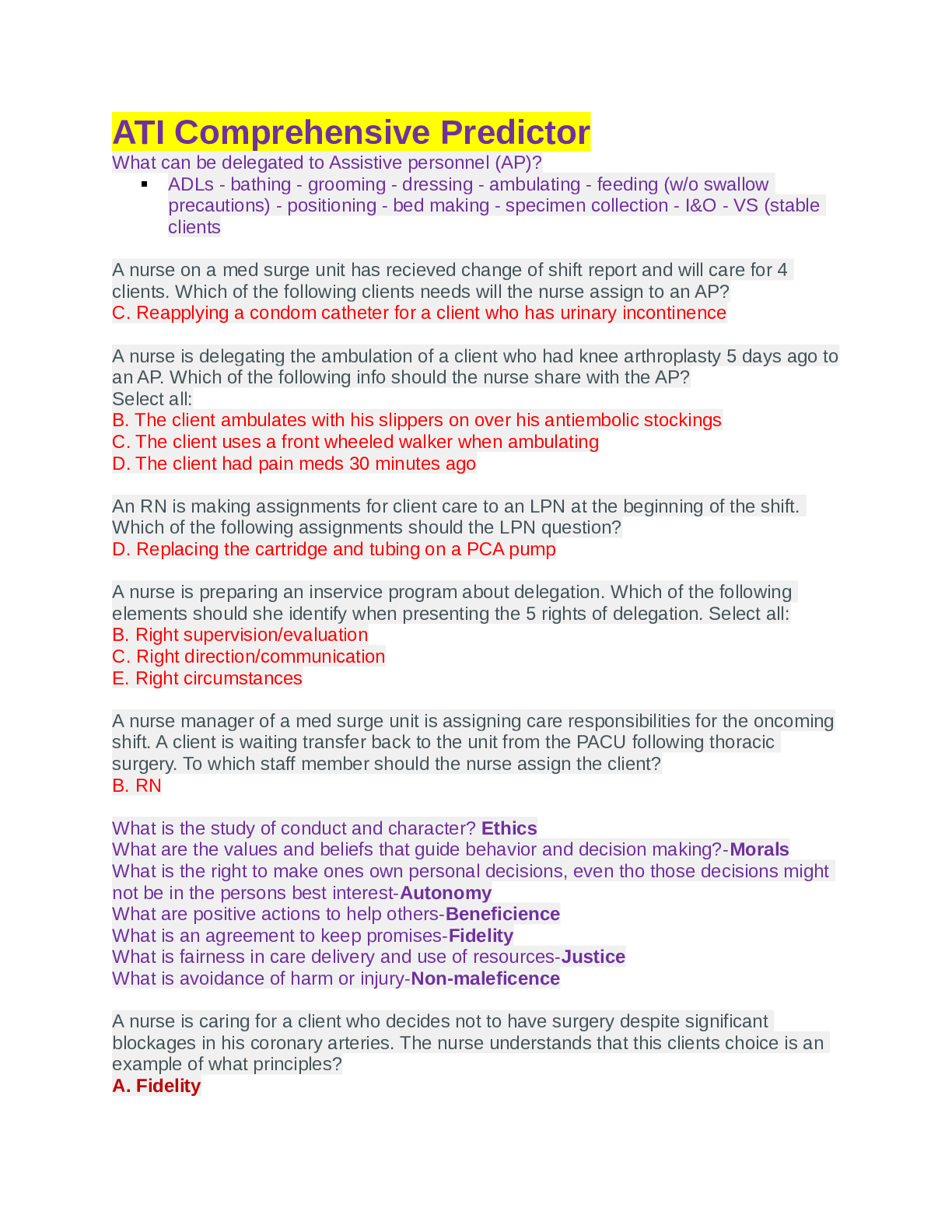
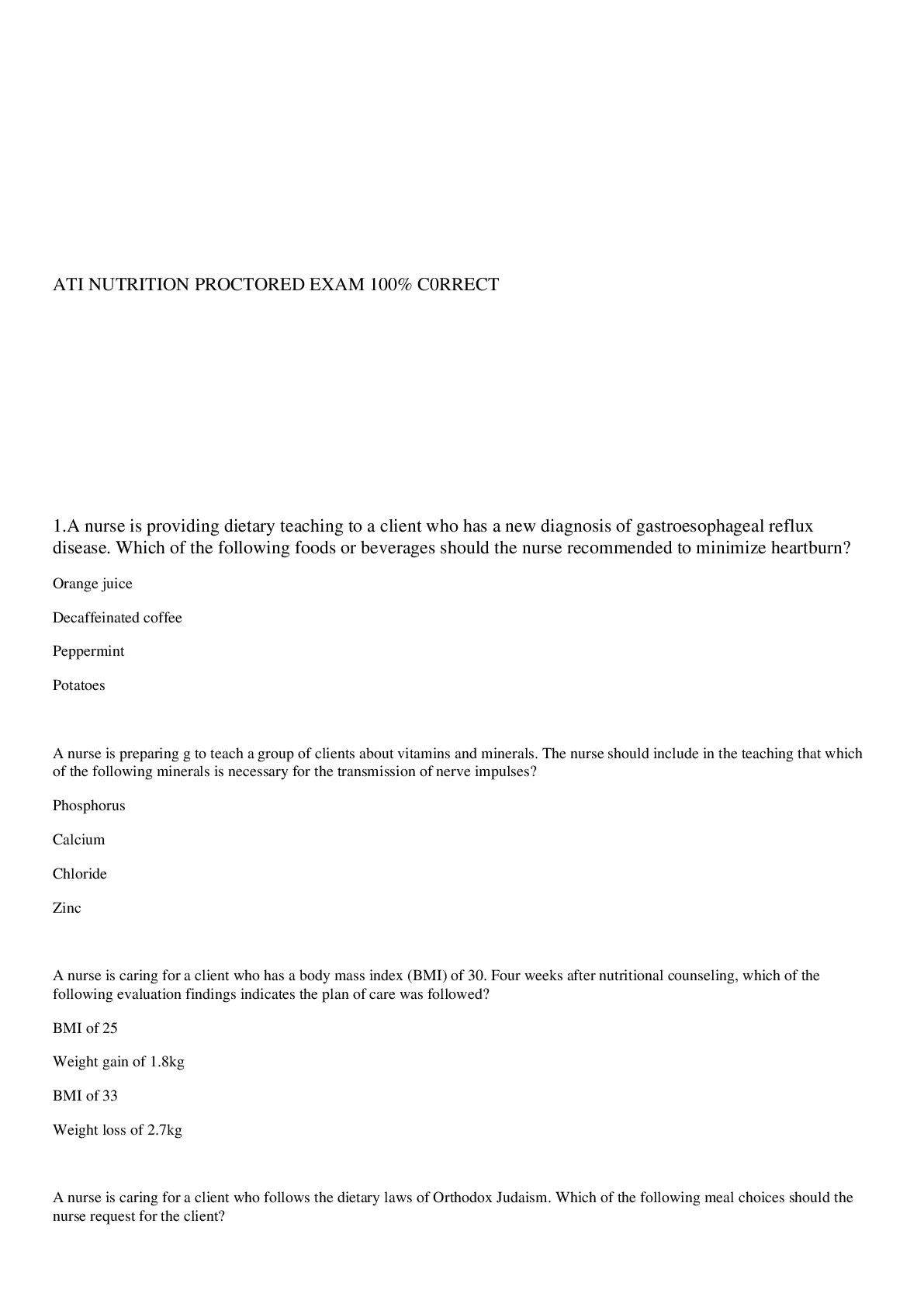
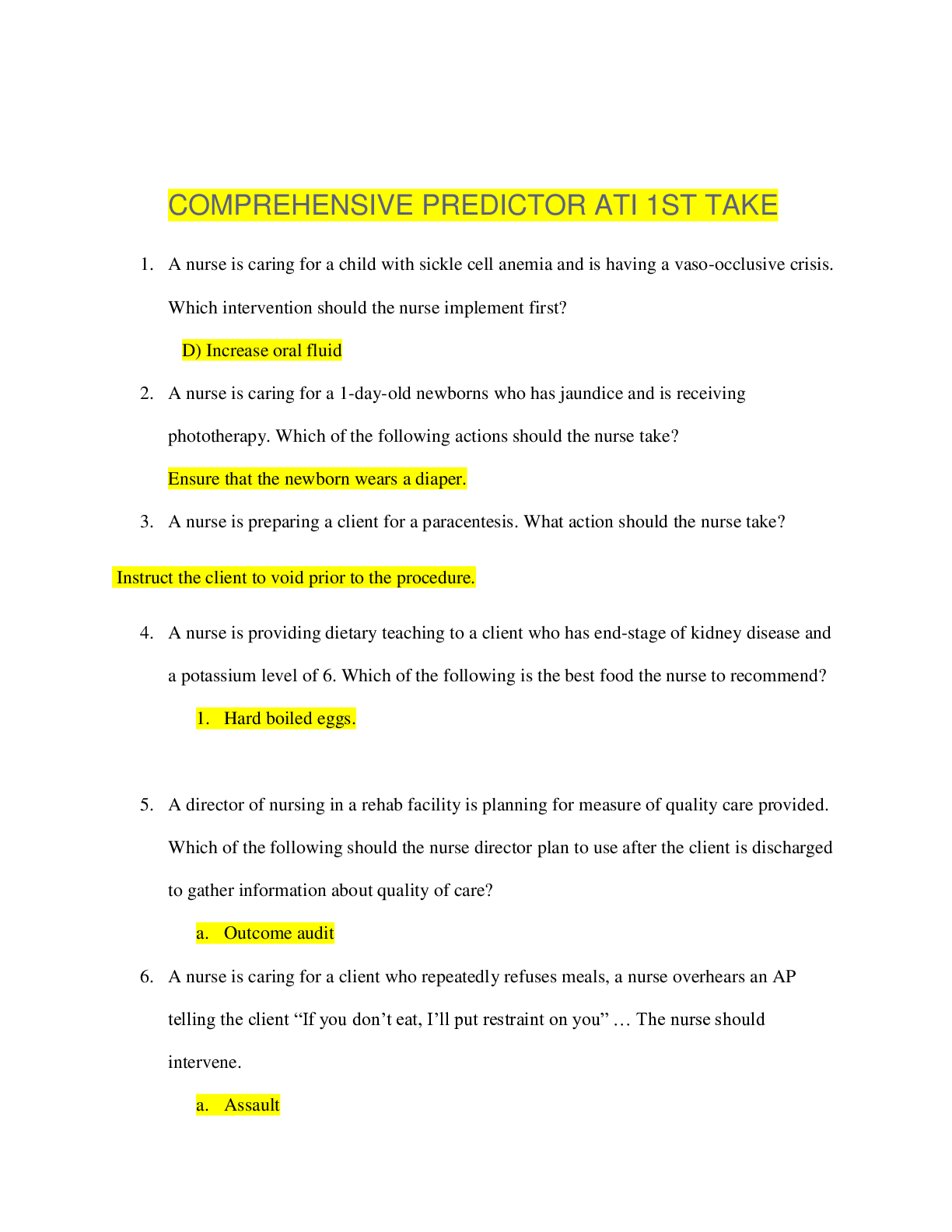
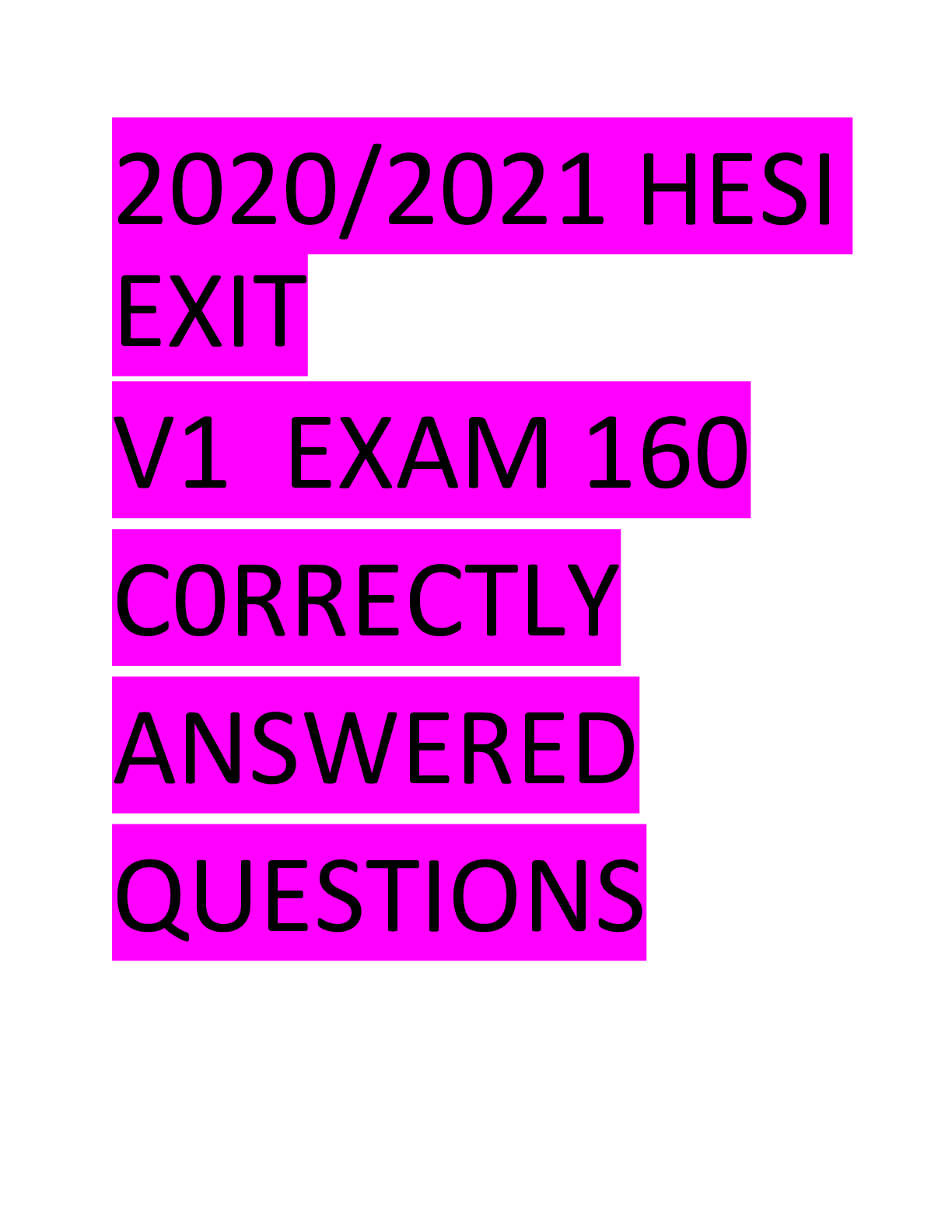
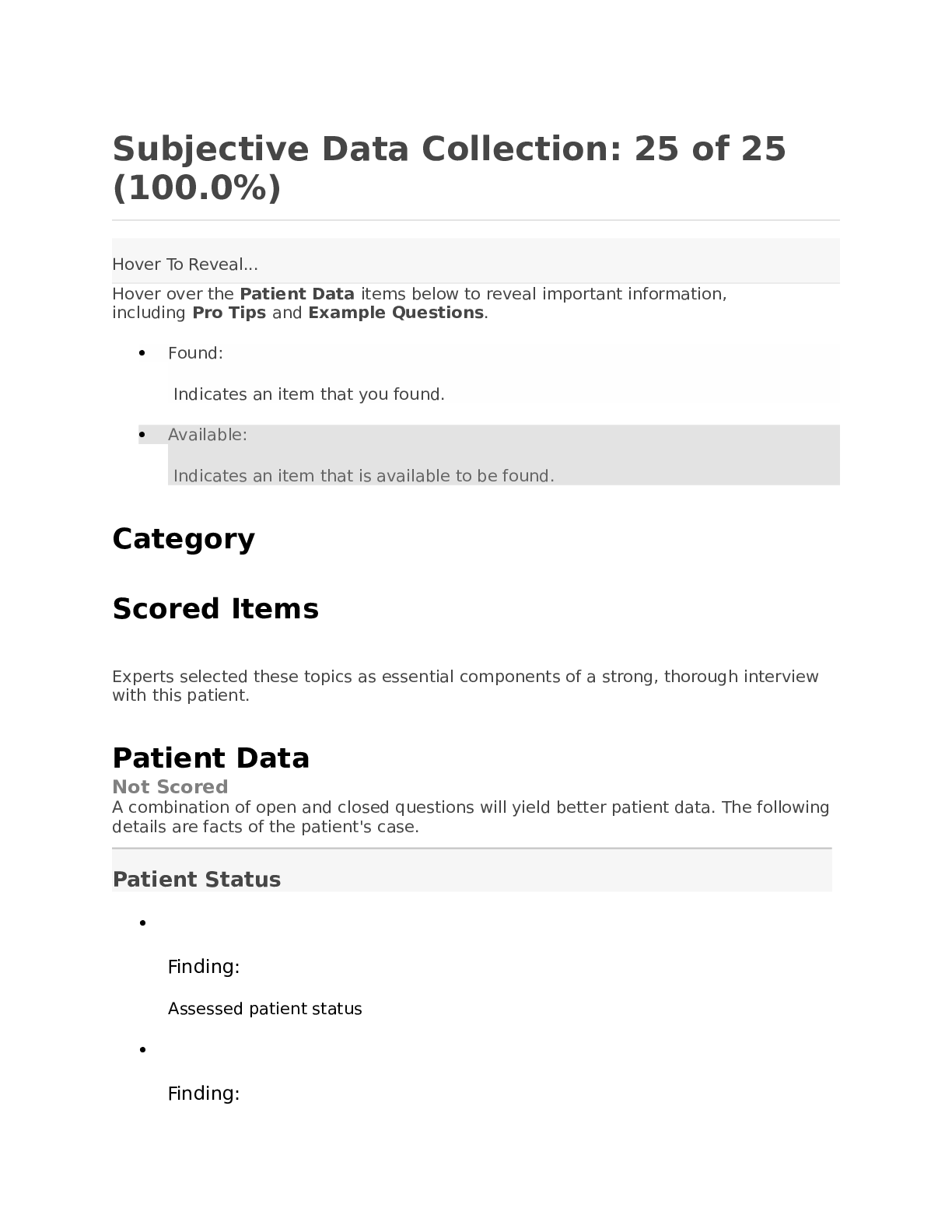

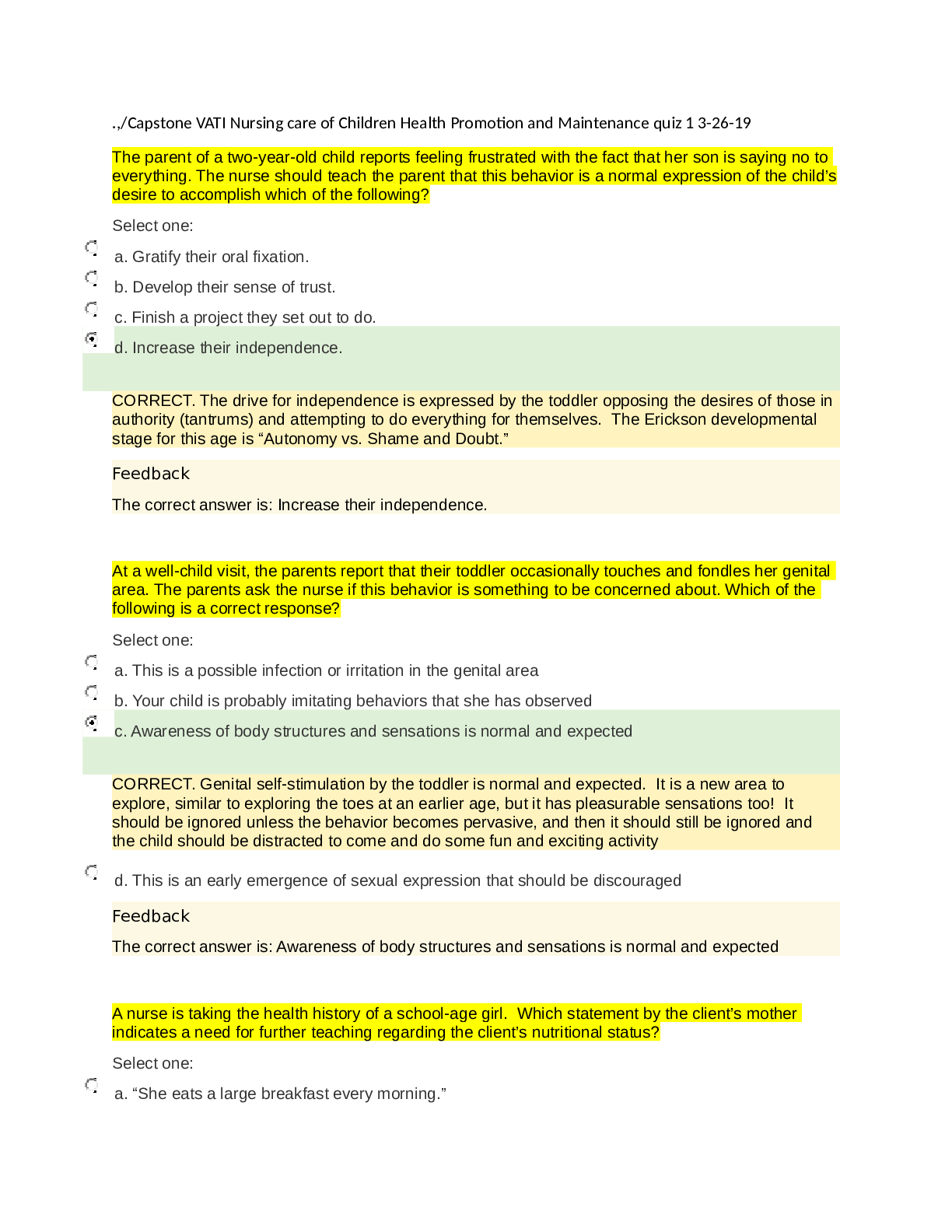
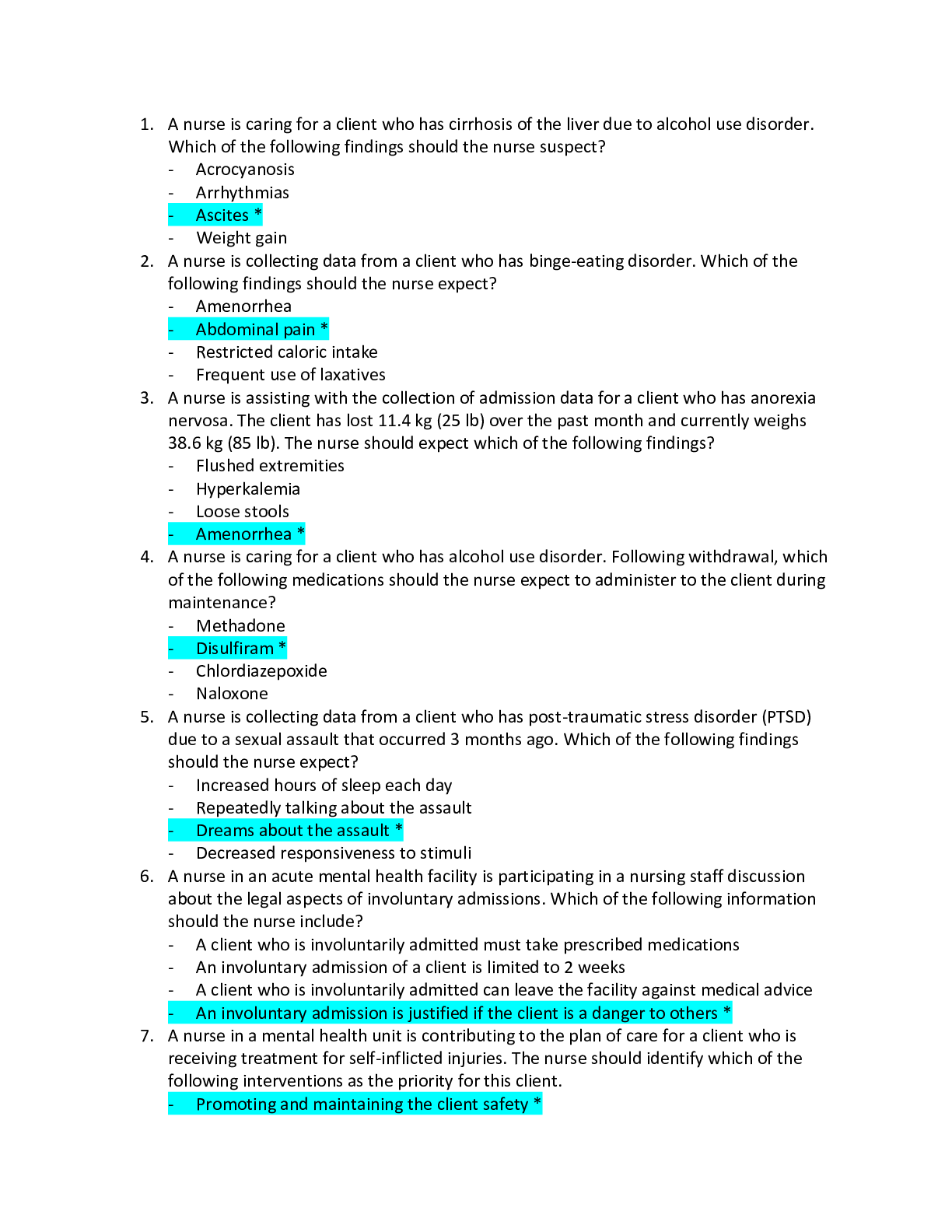
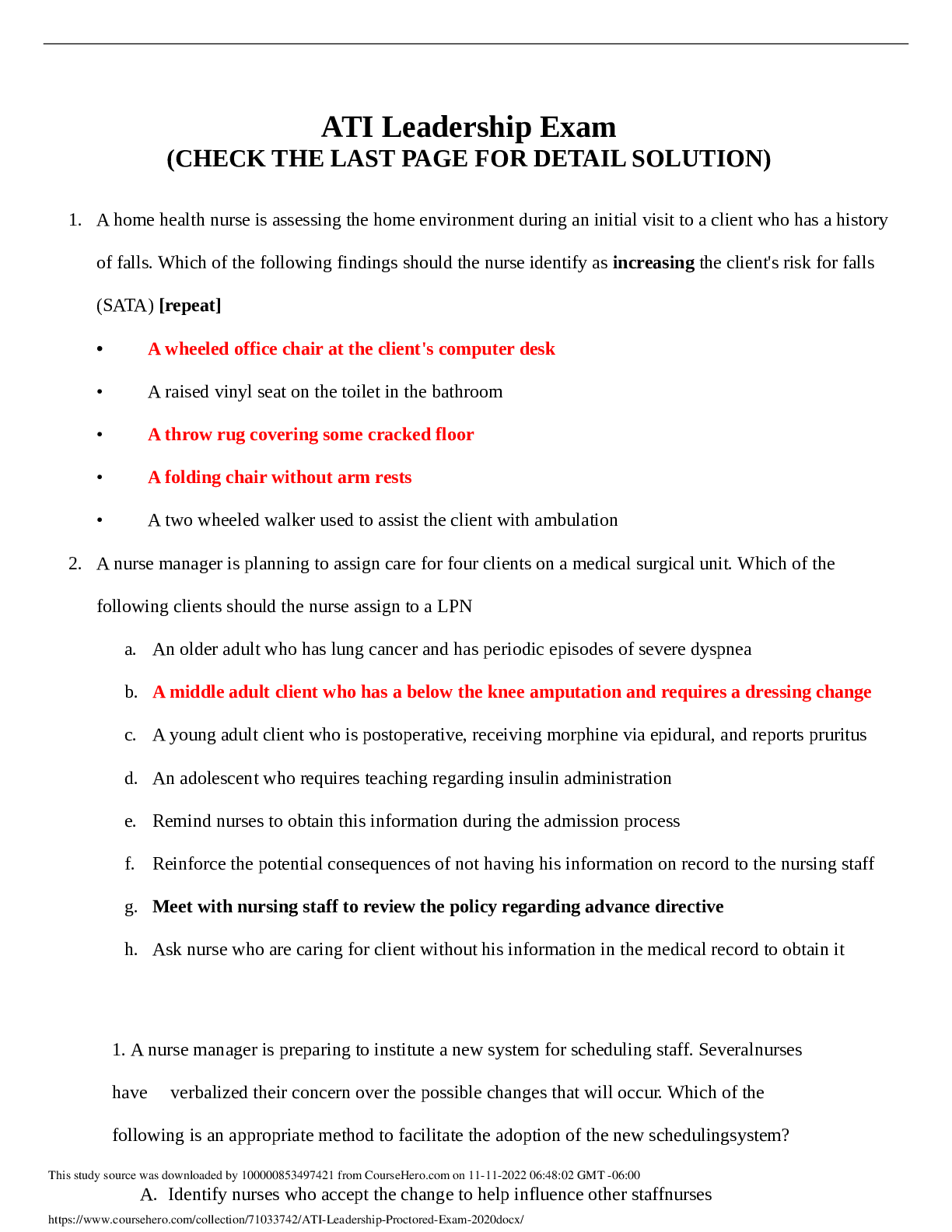


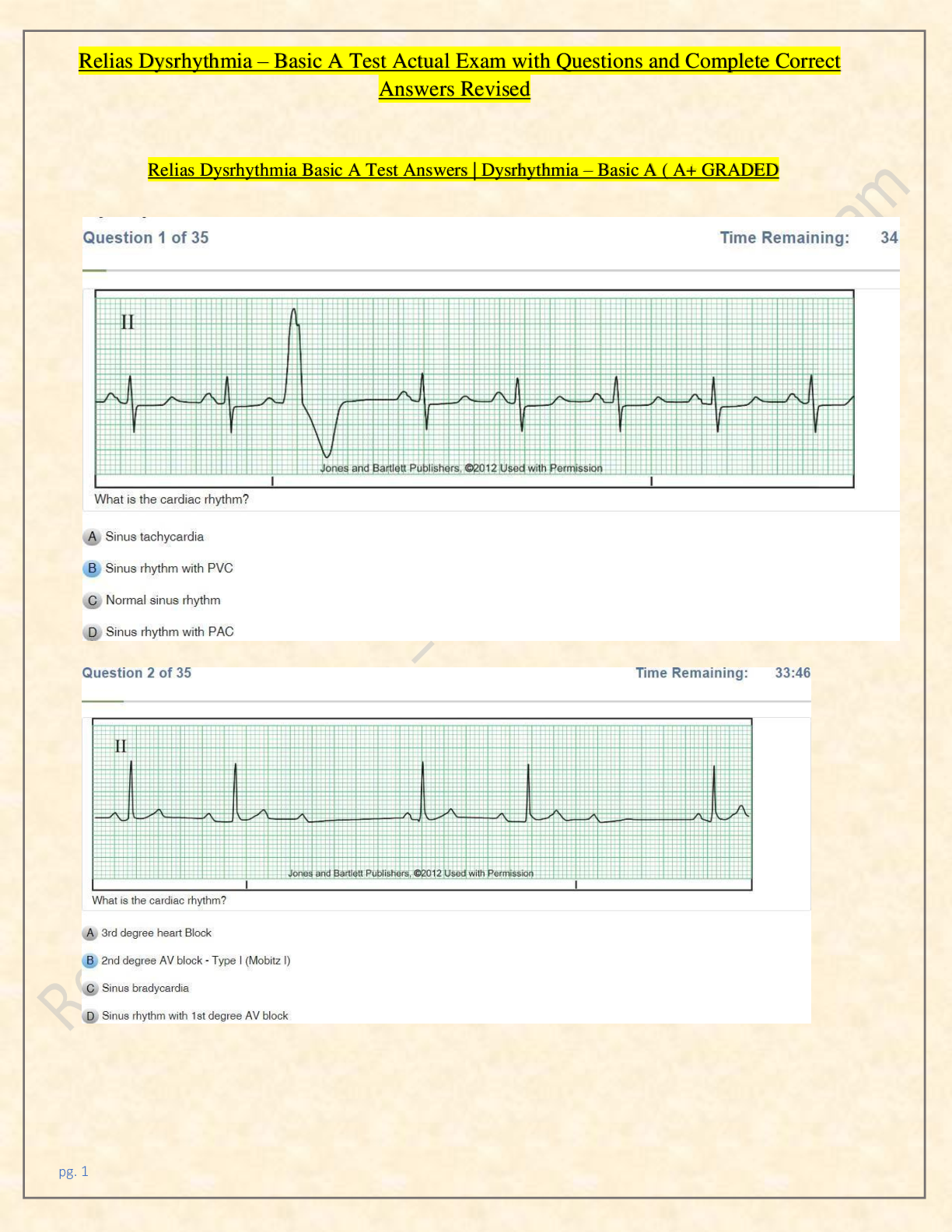
.png)
